Fostex MR-8HD User Manual

8588062100
(428387)
Owner’s Manual
Digital Multitracker
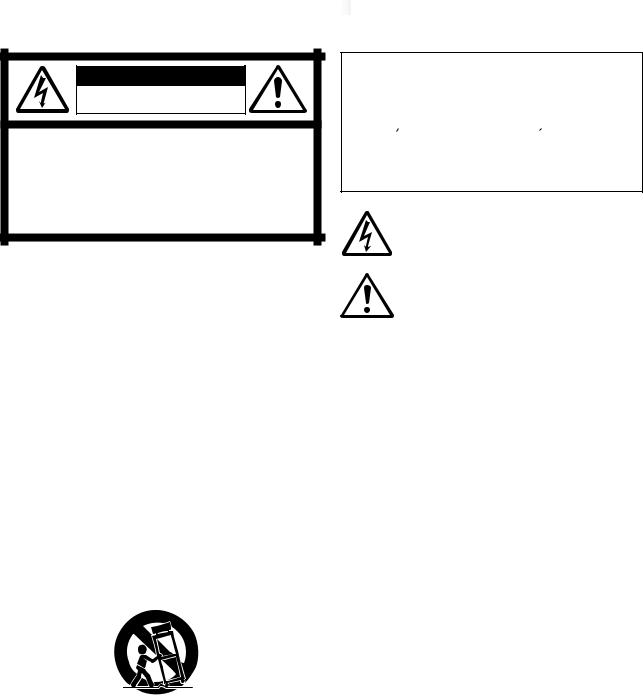
MR-8HD Owner’s Manual (Safety instructions/Contents)




















































CAUTION
RISK OF ELECTRIC SHOCK
DO NOT OPEN
CAUTION: TO REDUCE THE RISK OF ELECTRIC SHOCK,
DO NOT REMOVE COVER (OR BACK).
NO USER - SERVICEABLE PARTS INSIDE.
REFER SERVICING TO QUALIFIED SERVICE PERSONNEL.
"WARNING"
"TO REDUCE THE RISK OF FIRE OR ELECTRIC SHOCK, DO NOT EXPOSE THIS APPLIANCE TO RAIN OR MOISTURE."
SAFETY INSTRUCTIONS
1.Read Instructions - All the safety and operating instructions should be read before the appliance is operated.
2.Retain Instructions - The safety and operating instructions should be retained for future reference.
3.Heed Warnings - All warnings on the appliance and in the operating instructions should be adhered to.
4.Follow Instructions - All operating and use instructions should be followed.
5.Water and Moisture - The appliance should not be used near water - for example, near a bathtub, washbowl, kitchen sink, laundry tub, in a wet basement, or near a swimming pool, and the like.
6.Carts and Stands - The appliance should be used only with a cart or stand that is recommended by the manufacturer.
An appliance and cart combination should be moved with care. Quick stops, excessive force, and uneven surfaces may cause the appliance and cart combination to overturn.
7.Wall or Ceiling Mounting - The appliance should be mounted to a wall or ceiling only as recommended by the manufacturer.
8.Ventilation - The appliance should be situated so that its location or position dose not interfere with its proper ventilation. For example, the appliance should not be situated on a bed, sofa, rug, or similar surface that may block the ventilation openings; or, placed in a built-in installation, such as a bookcase or cabinet that may impede the flow of air through the ventilation openings.
9.Heat - The appliance should be situated away from heat sources such as radiators, heat registers, stoves, or other appliances (including amplifiers) that produce heat.
10.Power Sources - The appliance should be connected to a power supply only of the type described in the operating instructions or as marked on the appliance.
CAUTION:
TO PREVENT ELECTRIC SHOCK, MATCH WIDE BLADE OF PLUG TO WIDE SLOT, FULLY INSERT.
ATTENTION:
P O U R E V I T E R L E S C H O C S E L E C T R I Q U E S , INTRODUIRE LA LAME LA PLUS LARGE DE LA FICHE DANS LA BORNE CORRESPONDANTE DE LA PRISE ET POUSSER JUSQU' AU FOND.
The lightning flash with arrowhead symbol, within an equilateral triangle, is intended to alert the user to the presence of uninsulated "dangerous voltage" within the product's enclosure that may be of sufficient magnitude to constitute a risk of electric shock to persons.
The exclamation point within an equilateral triangle is intended to alert the user to the presence of important operating and maintenance (servicing) instructions in the literature accompanying the appliance.
11.Grounding or Polarization - The precautions that should be taken so that the grounding or polarization means of an appliance is not defeated.
12.Power Cord Protection - Power supply cords should be routed so that they are not likely to be walked on or pinched by items placed upon or against them, paying particular attention to cords at plugs, convenience receptacles, and the point where they exit from the appliance.
13.Cleaning - The appliance should be cleaned only as recommended by the manufacturer.
14.Nonuse Periods - The power cord of the appliance should be unplugged from the outlet when left unused for a long period of time.
15.Object and Liquid Entry - Care should be taken so that objects do not fall and liquids are not spilled into the enclosure through openings.
16.Damage Requiring Service - The appliance should be serviced by qualified service personnel when:
A.The power supply cord or the plug has been damaged; or
B.Objects have fallen, or liquid has been spilled into the appliance; or
C.The appliance has been exposed to rain; or
D.The appliance does not appear to operate normally or exhibits a marked change in performance; or
E.The appliance has been dropped, or the enclosure damaged.
17.Servicing - The user should not attempt to service the appliance beyond that described in the operating instructions. All other servicing should be referred to qualified service personnel.
18.The appliance should be situated away from drops of water or spray of water.
19.Objects containing liquid such as vase must not be put on the appliance.
20.The appliance is not completely isolated from the power supply even if the power switch is at off position.
21.Apparatus shall not be exposed to dripping or splashing and no objects filled with liquids, such as vases, shall be placed on the apparatus.
22.Only use attachments/accessories specified by the manufacturer.
23.An appliance with a protective earth terminal should be connected to a mains outlet with a protective earth connection.
24.An appliance should be placed in a position where an AC plug / inlet can be easily pulled out by hand.
2

































































 MR-8HD Owner’s Manual (Safety instructions/Contents)
MR-8HD Owner’s Manual (Safety instructions/Contents)
Important Safety Instructions
1)Read these instructions.
2)Keep these instructions.
3)Heed all warnings.
4)Follow all instructions.
5)Do not use this apparatus near water.
6)Clean only with dry cloth.
7)Do not block any ventilation openings. Install in accordance with the manufacturer's instructions.
8)Do not install near any heat sources such as radiators, heat registers, stoves, or other apparatus (including amplifiers) that produce heat.
9)Do not defeat the safety purpose of the polarized or grounding-type plug.
A polarized plug has two blades with one wider than the other. A grounding type plug has two blades and a third grounding prong. The wide blade or the third prong are provided for your safety.
If the provided plug does not fit into your outlet, consult an electrician for replacement of the obsolete outlet.
10)Protect the power cord from being walked on or pinched particularly at plugs, convenience receptacles, and the point where they exit from the apparatus.
11)Only use attachments/accessories specified by the manufacturer.
12)Use only with the cart, stand, tripod, bracket, or table specified by the manufacturer, or sold with the apparatus. When a cart is used, use caution when moving the cart/apparatus combination to avoid injury from tip-over.
13)Unplug this apparatus during lightning storms or when unused for long periods of time.
14)Refer all servicing to qualified service personnel. Servicing is required when the apparatus has been damaged in any way, such as power-supply cord or plug is damaged, liquid has been spilled or objects have fallen into the apparatus, the apparatus has been exposed to rain or moisture, does not operate normally, or has been dropped.
3

MR-8HD Owner’s Manual (Safety instructions/Contents) |
|
Table of contents |
|
Safety Instructions ................................................................................................................. |
2 |
Read this chapter first! ............................................................................................................. |
9 |
Introduction .......................................................................................................................... |
10 |
MR-8HD main features ........................................................................................................ |
10 |
Precautions before using ................................................................................................... |
11 |
About power supply ................................................................................................... |
11 |
Precautions upon installing the MR-8HD ............................................................... |
11 |
Notes on repair ........................................................................................................... |
11 |
About copyrights ........................................................................................................ |
11 |
About damages ........................................................................................................... |
11 |
Note on audio interruption ....................................................................................... |
11 |
Notes on USB connection with Mac OS .................................................................... |
11 |
The basics of the MR-8HD .................................................................................................. |
12 |
Recording method ...................................................................................................... |
12 |
About song ................................................................................................................... |
13 |
Remain (recordable space left on the disk) ............................................................ |
13 |
Time base ..................................................................................................................... |
14 |
Input and repro monitor ........................................................................................... |
14 |
TRIM control ................................................................................................................ |
15 |
Names and functions ............................................................................................................. |
17 |
Top panel 1 ............................................................................................................................ |
18 |
Top panel 2 ............................................................................................................................ |
20 |
Rear panel ............................................................................................................................. |
22 |
LCD display .......................................................................................................................... |
23 |
Home screen ................................................................................................................ |
23 |
Selecting a time base mode ...................................................................................... |
24 |
Adjusting the display contrast ................................................................................. |
24 |
MENU mode screen .................................................................................................... |
25 |
Warning message ....................................................................................................... |
25 |
Basic operations ..................................................................................................................... |
27 |
About power ......................................................................................................................... |
28 |
Power connection ....................................................................................................... |
28 |
About the standby mode ...................................................................... |
28 |
Turning on the unit .................................................................................................... |
28 |
Listening the demo song .................................................................................................... |
29 |
Connecting headphones (or monitor speaker system) ........................................ |
29 |
Playing back the demo song ..................................................................................... |
30 |
Creating a song for recording .......................................................................................... |
31 |
4

































































 MR-8HD Owner’s Manual (Safety instructions/Contents)
MR-8HD Owner’s Manual (Safety instructions/Contents)
Input connection .................................................................................................................. |
33 |
Input channel .............................................................................................................. |
33 |
INPUT A SEL switch ..................................................................................................... |
33 |
Recording track combinations and available input channel(s) .......................... |
34 |
Recording onto a single track ............................................................................................ |
35 |
Preparation for recording ......................................................................................... |
35 |
Starting recording ...................................................................................................... |
36 |
Playing back the recorded track ............................................................................... |
36 |
Undoing recording (undo/redo) ............................................................................. |
36 |
Overdubbing basics ............................................................................................................ |
37 |
Preparation for recording ......................................................................................... |
37 |
Adjusting the recording levels while listening to track 1 ..................................... |
38 |
Starting recording ...................................................................................................... |
38 |
Playing back recorded track ..................................................................................... |
38 |
Undoing recording (undo/redo) ............................................................................. |
38 |
Recording onto four tracks simultaneously .................................................................... |
39 |
Preparation for recording ......................................................................................... |
39 |
Starting recording ...................................................................................................... |
40 |
Playing back recorded tracks .................................................................................... |
40 |
Undoing recording (undo/redo) ............................................................................. |
40 |
Basic mixdown ..................................................................................................................... |
41 |
Mixdown to an analog recorder ............................................................................... |
41 |
Mixdown to a digital recorder .................................................................................. |
42 |
Advanced playback and locates functions ......................................................................... |
43 |
3 x cueing .............................................................................................................................. |
44 |
Playback between LOCATE A and B points ..................................................................... |
44 |
Play mode .............................................................................................................................. |
45 |
Selecting a play mode ................................................................................................ |
45 |
Auto play mode ........................................................................................................... |
46 |
Auto return mode ....................................................................................................... |
46 |
Loop mode ................................................................................................................... |
46 |
Loop function in auto punch in/out mode ........................................ |
47 |
Locate function .................................................................................................................... |
48 |
Time locate .................................................................................................................. |
48 |
Locating to the beginning (ABS ZERO) of a song ............................... |
48 |
Locating to the recording end point (REC END) of a song ............... |
48 |
Locating to the LOCATE A or LOCATE B point ........................................................ |
49 |
Setting the LOCATE A or LOCATE B point .......................................... |
49 |
Locating ................................................................................................... |
50 |
Punch in/out ............................................................................................................................. |
51 |
Punch in/out using the keys on the top panel .................................................................. |
52 |
Punch in/out using the footswitch ..................................................................................... |
53 |
Auto punch in/out ................................................................................................................. |
54 |
Setting the punch-in and punch-out points ........................................................... |
54 |
Rehearsal for auto punch in/out .............................................................................. |
55 |
Actual auto punch in/out .......................................................................................... |
56 |
5

MR-8HD Owner’s Manual (Safety instructions/Contents) |
|
Using effects ............................................................................................................................ |
57 |
Using the insert effects ....................................................................................................... |
58 |
Mic simulation effects ................................................................................................ |
58 |
Amp simulation effects .............................................................................................. |
58 |
Applying external effects .................................................................................................... |
59 |
Using the reverb or delay .................................................................................................... |
60 |
Selecting an effect type .............................................................................................. |
60 |
Selecting a delay type ................................................................................................ |
60 |
Adjusting the delay/reverb time ............................................................................. |
61 |
Adjusting the effect send levels ................................................................................ |
61 |
Using the mastering effects ............................................................................................... |
62 |
Selecting the desired effect type .............................................................................. |
62 |
Track bouncing ....................................................................................................................... |
63 |
Preliminary knowledge ....................................................................................................... |
64 |
Track bouncing example ........................................................................................... |
64 |
Signal flow of track bouncing ................................................................................... |
65 |
Bouncing tracks 1 through 4 to tracks 5/6 ........................................................................ |
66 |
Rehearsal of track bouncing ..................................................................................... |
66 |
Actual track bouncing ............................................................................................... |
67 |
Checking the bounced signals on tracks 5/6 ......................................................... |
67 |
Bouncing tracks 1 through 6 to tracks 7/8 ........................................................................ |
68 |
Rehearsal of track bouncing ..................................................................................... |
68 |
Actual track bouncing ............................................................................................... |
69 |
Checking the bounced signals on tracks 7/8 ......................................................... |
69 |
Bouncing tracks 1 through 8 to a new song ..................................................................... |
70 |
Rehearsal of track bouncing ..................................................................................... |
70 |
Actual track bouncing ............................................................................................... |
71 |
Mixing signals of inputs A through D ................................................................................ |
72 |
Connecting sound sources to INPUT A through INPUT D .................................... |
72 |
[TO STEREO BUSS ON/OFF] key setting ................................................................... |
72 |
Panning setting for INPUT A through INPUT D ...................................................... |
73 |
Bouncing the desired part of a song ................................................................................. |
74 |
Rhythm guide function .......................................................................................................... |
75 |
Using the rhythm guide function ....................................................................................... |
76 |
Setting the time signature and tempo ..................................................................... |
76 |
Creating the conductor map .............................................................................................. |
78 |
Setting the signature map ......................................................................................... |
78 |
Editing a time signature event ............................................................. |
80 |
Deleting an unnecessary time signature event ................................. |
80 |
Editing the bar offset .................................................................................................. |
81 |
Setting the tempo map ............................................................................................... |
82 |
Editing a tempo event ........................................................................... |
84 |
Deleting an unnecessary tempo event ............................................... |
84 |
6

































































 MR-8HD Owner’s Manual (Safety instructions/Contents)
MR-8HD Owner’s Manual (Safety instructions/Contents)
MIDI synchronization ............................................................................................................. |
85 |
Synchronization using MTC ............................................................................................... |
86 |
Connection .................................................................................................................. |
86 |
Settings of the MR-8HD and MIDI sequencer ......................................................... |
86 |
MIDI sync/MTC frame rate settings ......................................................................... |
86 |
Synchronization using MIDI clock ..................................................................................... |
87 |
Connection .................................................................................................................. |
87 |
Settings of the MR-8HD and MIDI sequencer ......................................................... |
87 |
Data export to a personal computer ..................................................................................... |
89 |
WAV file conversion ............................................................................................................. |
90 |
Enabling the file conversion ..................................................................................... |
90 |
Procedure of file conversion ..................................................................................... |
90 |
Exporting data to a personal computer ............................................................................ |
92 |
Connection to a personal computer ........................................................................ |
92 |
Notes on exporting a file ............................................................................................ |
92 |
Exporting a WAV file to a personal computer ........................................................ |
93 |
Protecting the hard disk ...................................................................................................... |
94 |
Archiving a song .................................................................................................................. |
95 |
Song management ................................................................................................................. |
97 |
Selecting the desired song ................................................................................................. |
98 |
Editing a song name ............................................................................................................ |
99 |
Deleting an unnecessary song ...................................................................................... |
100 |
Protecting a song ............................................................................................................. |
101 |
Track editing .......................................................................................................................... |
103 |
Erasing track data .............................................................................................................. |
104 |
Copying/pasting track data .............................................................................................. |
105 |
Moving track data ............................................................................................................... |
107 |
Exchanging whole track data ........................................................................................... |
108 |
Part editing ............................................................................................................................. |
111 |
Playing back the “part” (Between LOCATE A and LOCATE B) to be edited...... |
112 |
Changing an edit point during editing ................................................................. |
112 |
Editing the part(s) .............................................................................................................. |
113 |
Copying/pasting the part(s)-1 .......................................................................................... |
114 |
Copying/pasting the part(s)-2 .......................................................................................... |
116 |
Copying to the clipboard ........................................................................................ |
116 |
Pasting clipboard data ............................................................................................. |
117 |
7

MR-8HD Owner’s Manual (Safety instructions/Contents) |
|
Moving the part(s) ............................................................................................................ |
.119 |
Exchange the parts ............................................................................................................ |
120 |
Other functions ..................................................................................................................... |
123 |
Hard disk formatting .......................................................................................................... |
124 |
Peak hold time setting ....................................................................................................... |
125 |
Pre-roll/post-roll time setting ........................................................................................... |
126 |
Beat resolution mode on/off ............................................................................................. |
127 |
Phantom power on/off ....................................................................................................... |
128 |
Initializing the MR-8HD ...................................................................................................... |
130 |
Troubleshooting ................................................................................................................... |
131 |
Trouble for recording ......................................................................................................... |
132 |
Trouble for playback .......................................................................................................... |
133 |
Trouble for effect ................................................................................................................ |
134 |
Trouble for USB connection ............................................................................................. |
134 |
Other troubles ..................................................................................................................... |
135 |
MR-8HD Specifications ........................................................................................................ |
137 |
Specifications ..................................................................................................................... |
138 |
Physical dimensions ......................................................................................................... |
139 |
Block diagram .................................................................................................................... |
140 |
MIDI implementation chart ............................................................................................... |
142 |
Index .................................................................................................................................... |
143 |
Declaration of EC Directive .............................................................................................. |
144 |
8

























































 MR-8HD Owner’s Manual (Read this chapter first!)
MR-8HD Owner’s Manual (Read this chapter first!)
Read this chapter first!
This chapter describes precautions before using, as well as features and basic knowledge of the MR-8HD.
To understand the MR-8HD features and basic functions, read this chapter before using.
9

MR-8HD Owner’s Manual (Read this chapter first!)




































































Introduction
Thank you very much for purchasing the Fostex MR-8HD digital multitracker.
The MR-8HD is a digital multitracker which can record 8-track audio at 44.1 kHz/16 bits on the internal 3.5-inch hard disk. Up to four tracks can be recorded simultaneously.
The MR-8HD is also equipped with an 8-channel digital mixer, digital effects including the delay/reverb, mastering effects and insert effects (simulation effects). It allows you to carry out all the process for digital multitrack recording including overdubbing, track bouncing and mixdown within the digital domain, ensuring no loss of sound quality.
MR-8HD main features
•You can record high quality audio to the built-in high performance 3.5-inch hard disk drive (40MB).
You can also edit recorded audio later without sound deterioration.
Up to 99 songs can be recorded.
•Provides four analog input channels and up to four tracks can be recorded simultaneously.
Signals of four input channels ([INPUT A] through [INPUT D]) can be mixed to the stereo buss (Pre mastering effects).
•You can bounce all eight tracks to a new song, which is automatically created in the bouncing process.
•An ASP digital effect processor (delay/ reverb) with the algorithm newly developed by Fostex is built in, allowing effect processing to tracks 1 through 4 during track bouncing.
In addition, the MR-8HD also provides insert effects for microphone and amplifier simulation for coloring sounds.
•The dedicated mastering effects are built in for the stereo buss, allowing you to process sounds during track bouncing or final mixdown.
•The adoption of self-illuminated keys allows intuitive operation.
•Phantom power is built in, allowing direct connection of condenser microphones.
•The rhythm guide function is provided. You can make global time signature/tempo setting for a simple song or create a conductor map for a more complicate song, and output the guide click.
•Song data (on mono WAV files on tracks 7 and 8) mastered by the MR-8HD can be converted to a stereo WAV file easily. You can export the converted file to a personal computer and create an audio CD using the CD burn function of the PC.
•The [DIGITAL OUT] port outputs S/PDIF format digital signals. You can make mixdown or digital copy to an external DAT or MD recorder.
•The whole or a part of track data can be edited (i.e. copied, pasted, moved, exported, exchanged and erased).
•The [MIDI OUT] port is provided.
You can synchronize the MR-8HD with external MIDI devices (MIDI sequencer, etc.) using MTC or MIDI clock.
10
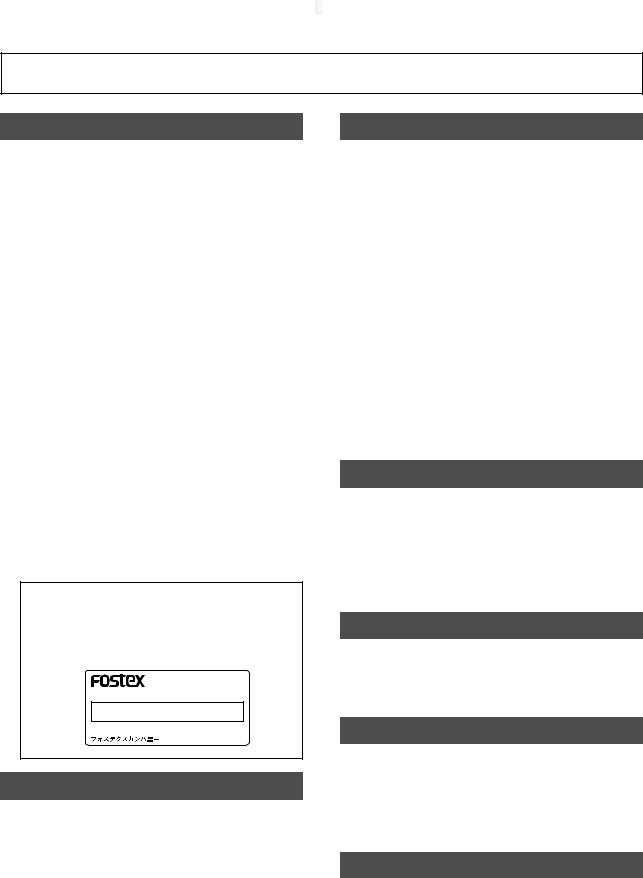
























































 MR-8HD Owner’s Manual (Read this chapter first!)
MR-8HD Owner’s Manual (Read this chapter first!)
Precautions before using
About power supply
•Be sure to connect the MR-8HD to the power supply specified in the specifications section of this owner's manual. Do not use an AC outlet of any other voltage.
•Do not connect the MR-8HD to the same AC outlet to which devices that could generate noise (such as a large motor or dimmer), or the devices that consume a large amount of power (such as an air conditioning system or large electric heater) are connected.
•If you use the MR-8HD in an area with a different power voltage, first consult your dealer or the nearest Fostex service station.
•The [POWER] switch cannot turn off the power completely. When this switch is "up", the MR-8HD enters standby mode (i.e. the power does not completely turned off). Therefore, if you do not use the MR-8HD for a long time, we recommend unplugging the power cord from the AC outlet.
•It is very dangerous to use a power cord that is frayed or damage. In such a case, stop using the MR-8HD immediately and ask your dealer to repair the cord.
<Important! >
Model name, power requirement, serial number and other information for the MR-8HD are shown at the bottom of the unit.
MODEL MR-8HD
DIGITAL MULTITRACKER
FOSTEX CO. |
|
|
100 - 230V ~ |
14W |
60Hz |
SERIAL NO.
MADE IN CHINA
Precautions upon installing the MR-8HD
•Do not install the MR-8HD in locations subject to the following:
*Extremely high or low temperature, or significant changes in temperature.
*Excessive humidity or dust.
*Excessive changes in power supply voltage.
*Unstable or significantly vibrating or shaking surfaces.
*Near a strong magnetic field (such as a TV or speaker).
Notes on repair
•The MR-8HD does not use any parts that user can repair easily. Contact your dealer or the nearest Fostex service station to ask about repairs.
•Use the original packing carton of the MR-8HD when you transport or send the MR-8HD to the dealer or Fostex service station for repair.
If you have discarded the packing carton, pack the MR-8HD using shock absorbing materials. Fostex is not responsible for malfunction or damage due to incomplete packaging or caused during transportation.
•Because the MR-8HD is a consumer product, Fostex does not offer on-site service or provide a loaner unit while your MR-8HD is under repair.
About copyrights
•It is prohibited by law to use any part of a CD recording or video images or audio data for which copyright is possessed by a third party for commercial purposes such as contents, broadcasts, sales, or distribution-any purpose other than for your personal pleasure.
About damages
•Fostex is not responsible for any "direct damage" or "indirect damage" caused by using the MR-8HD.
Notes on audio interruption
•If you make recording or editing to a song many times, audio may be occasionally interrupted when the song is played back, due to data fragmentation. Note that this is not a malfunction.
Note on USB connection with Mac OS
•Before you connect the MR-8HD to a Macintosh computer, make sure that the OS is Mac OS X or higher. The MR-8HD supports only Mac OS X or higher. If you connect the MR-8HD to a Macintosh computer with Mac OS lower than "OS X", song data on the MR-8HD may be damaged.
11
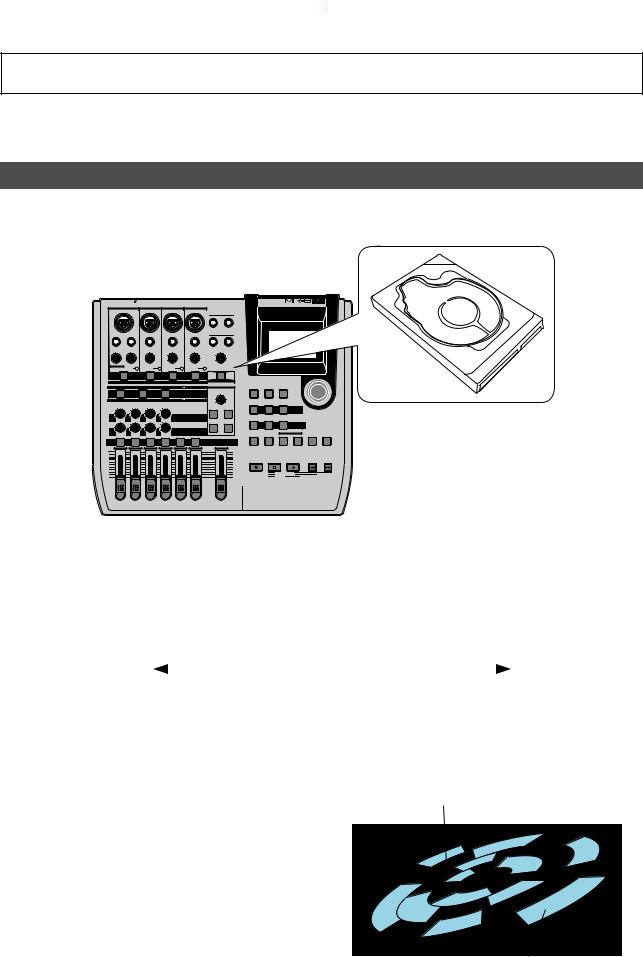
MR-8HD Owner’s Manual (Read this chapter first!)




































































The basics of the MR-8HD
This section describes the basics of the MR-8HD you should know before using the MR8HD.
Recording method
The MR-8HD is fitted with a 3.5-inch hard disk drive. Songs are recorded on a hard disk along with the ABS time (from 00m00s000ms to 99m59s999ms).
INPUT A SELECT 
DIGITAL MULTITRACKER
INPUT A |
|
INPUT B |
INPUT C |
INPUT D |
|
|
|
|
|
||||
BAL |
|
|
BAL |
|
BAL |
|
BAL |
|
STEREO OUT |
|
|
|
|
|
|
|
|
|
|
|
|
|
|
|
|
||
|
|
|
|
|
|
|
|
|
L |
R |
|
|
|
UNBAL |
|
|
UNBAL |
UNBAL |
|
|
PHONES |
|
|
|
|||
/GUITAR |
INSERT |
UNBAL |
1 |
2 |
|
|
|
||||||
DISTORTION |
TRIM |
|
TRIM |
|
TRIM |
|
TRIM |
|
PHONES VOL |
|
|
|
|
MIN MAX LINE |
MIC |
LINE |
MIC |
LINE |
MIC |
LINE |
MIC |
MIN |
MAX |
|
|
|
|
GUITAR |
|
|
PEAK |
|
PEAK |
|
PEAK |
|
|
|
|
|
|
|
PEAK |
|
|
|
|
|
|
|
|
|
|||
|
ON/ |
|
|
ON/ |
|
ON/ |
|
ON/ |
|
|
|
|
|
|
OFF |
|
|
OFF |
|
OFF |
|
OFF |
|
|
|
|
|
|
|
|
|
TO STEREO BUSS |
|
|
|
POWER |
|
|
|
||
DYNAMIC |
|
CONDENSER |
|
TUBE |
|
MIC SIMULATION |
EFFECT |
RHYTHM |
TIME BASE |
CONTRAST |
|||
|
|
|
GUIDE |
SELECT |
|||||||||
|
|
|
|
|
|
|
|
|
REVERB / DELAY TIME |
|
|
|
|
|
|
|
|
|
|
|
INPUT A |
|
|
|
|
|
|
BRIT STACK |
|
|
US METAL |
|
60'S COMBO |
|
AMP SIMULATION |
|
|
|
|
|
|
|
|
|
|
|
|
|
|
|
|
|
1-4 > 5/6 |
NEW |
STEREO |
|
|
|
|
|
|
|
|
|
MIN |
MAX |
1-6 > 7/8 |
1-8 >SONG |
7/8 >WAV FILE |
|
|
|
|
|
|
|
ROOM |
HALL |
|
BOUNCE |
|
|
|
|
|
|
|
|
|
|
MENU / ENTER |
|
|
|
|
|
|
|
EFFECT SEND |
ABC1 |
DEF2 |
GHI3 |
|
|
|
|
|
|
|
POWERFUL |
NATURAL |
BRIGHT |
|
0 |
10 |
0 |
10 |
0 |
10 |
0 |
10 |
|||
|
|
|
|
|
|
|
PLATE |
DELAY |
|
|
|
|
|
|
|
|
|
|
|
|
MASTERING |
|
|
|
|
L |
R |
L |
R |
PAN |
|
JKL4 |
MNO5 |
|
LOCATE |
|
|
L |
R |
L |
R |
|
|
AUTO PUNCH |
PLAY MODE |
A / IN |
STORE |
UNDO/REDO |
|||||
|
|
|
|
|
|
|
|
|
|
B / OUT |
|||||
|
|
|
|
|
|
|
|
|
REC SELECT |
|
|
|
|
|
|
|
1 |
|
2 |
|
3 |
4 |
5/6 |
7/8 |
MASTER |
PQR6 |
STU7 |
VWX8 |
YZ9 |
+-_0 |
DELETE |
MAX |
|
|
|
|
|
|
|
|
MAX |
|
|
|
|
|
|
|
|
|
|
|
|
|
|
|
|
RECORD |
STOP |
PLAY |
REWIND |
F FWD |
|
|
|
|
|
|
|
|
|
|
|
|
|
LOCATE REC END |
|
|
|
MIN |
|
|
|
|
|
|
|
|
MIN |
|
|
LOCATE ABS ZERO |
|
|
|
|
|
|
|
|
|
|
|
|
|
A-B PLAY |
|
|
|
||
3.5-inch hard disk drive
The ABS time shows the absolute time on a hard disk and you can start recording from any desired time within the range between 00m00s000ms and 99m59s999ms ABS time.
The beginning of a song
0m00s000ms |
|
|
|
15m00s000ms |
99m59s999ms |
||||
(ABS ZERO) |
05m00s000ms 10m00s000ms |
(REC END) |
|||||||
|
|
|
|
|
|
|
...... |
|
|
|
|
|
|
|
|
|
|
|
|
|
Recorded area |
Non-recorded area |
Recorded area |
Non-recorded area |
|
|
|||
|
|
|
|
||||||
|
|
|
|
|
|
|
|
|
|
|
|
|
|
|
|
||||
|
|
|
|
|
|
||||
|
|
You can start recording from any desired time within the range |
|
|
|
||||
|
|
|
|
|
|||||
|
|
between 00m00s000ms and 99m59s999ms ABS time. |
|
|
|
||||
As the MR-8HD does not consume the disk space when no audio is recorded, you can record audio effectively, while the recordable time for a tape recorder depends on the tape length.
Non recorded area (shown in white)
0m00s000ms |
|
99m59s999ms |
||
|
|
|
|
|
|
|
|
|
|
|
5-minute recording |
5-minute recording |
Non-recorded area (remain) ...... |
|
|
|
|
|
|
Recorded area (shown in gray)
12
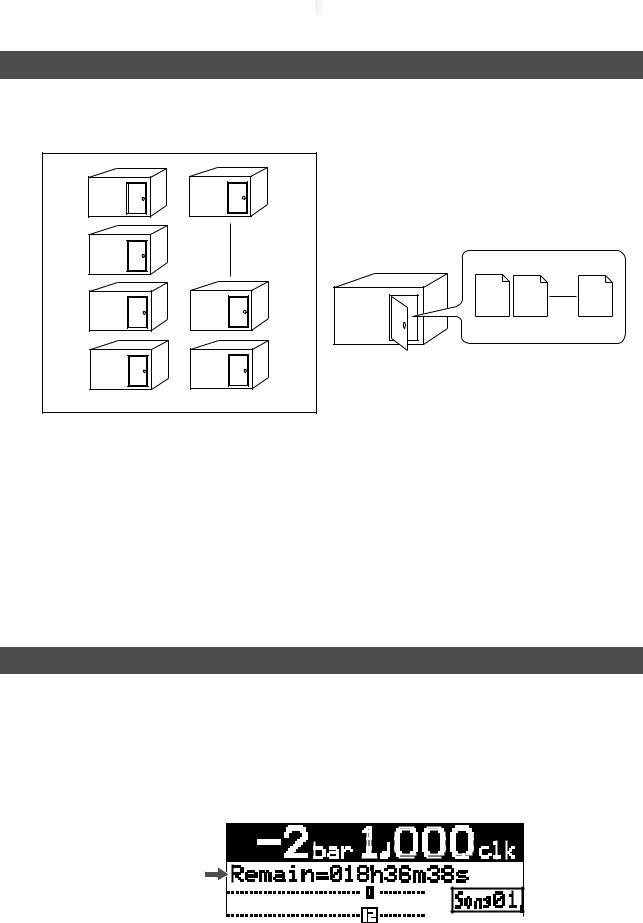
























































 MR-8HD Owner’s Manual (Read this chapter first!)
MR-8HD Owner’s Manual (Read this chapter first!)
About song
To understand songs, imagine separated rooms as shown below. Each room can be regarded as a song. With the MR-8HD, you can create up to 99 rooms (songs) on the hard disk (although the available space may limit the number of songs).
Song01 Song05
|
|
Recorded track data is stored in a song as mono WAV |
|
|
|
files, as shown below. |
|
Song02 |
|
|
|
|
|
Track 1 Track 2 |
Track 8 |
Song03 |
Song98 |
Song01 |
|
|
|
||
|
|
WAV files |
|
Song04 |
Song99 |
|
|
Each song is independent on a disk and you can record, play back or edit a song without affecting other songs.
You can give a desired song name for managing recorded songs (see page 99).
Recorded track data is stored in a song as mono WAV files.
The MR-8HD can convert the two WAV files recorded on tracks 7 and 8 (L and R) to a stereo WAV file (see page 90).
You can export the converted stereo WAV file to your USB-connected personal computer, and use the file by a music software application or make an original audio CD using a CD burn software application (see page 92).
Remain (recordable space left on the disk)
"Remain" shows how much time you can further record audio data to the available space left on the internal hard disk.
As described earlier, the MR-8HD stripes ABS time from 0m00s000ms to 99m59s999ms at maximum for each song. However, the remaining time (= available recording time left) depends on the available space on the hard disk in actual use. The remaining time is shown as in the screen example below during recording or record standby. Note that it shows the remaining time for recording onto a mono track.
Remain value |
A "mono" track means a single track. Therefore, you can calculate the remaining time for recording to more than one track by dividing the displayed time by the number of tracks. Note that the remaining time shown on the screen is an approximate time.
13
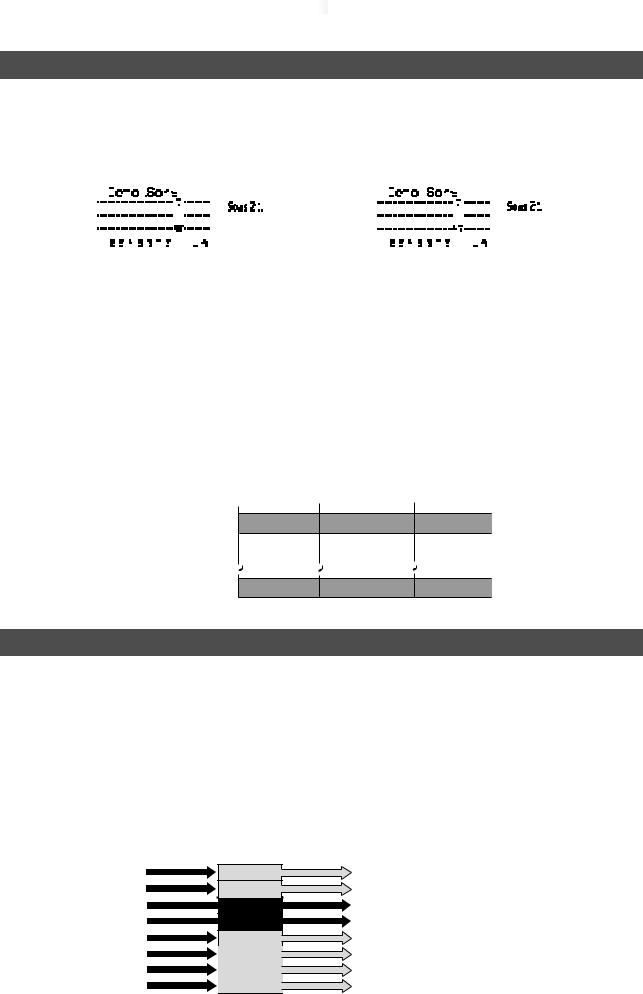
MR-8HD Owner’s Manual (Read this chapter first!)




































































Time base
The term, "time base", is used as the reference of recorder position information.
Using the [TIME BASE SELECT] key, you can select from among two time base modes: ABS time and bar/beat mode. Each screen example below shows the recorder is located at the beginning of a song in each time base mode.
|
|
|
|
|
|
|
|
|
|
|
|
|
|
|
|
|
|
|
|
|
|
|
|
|
|
|
|
|
|
|
|
|
|
|
|
|
|
|
|
|
|
|
|
|
|
|
|
|
|
|
|
|
|
|
|
|
|
|
|
|
|
|
|
|
|
|
|
|
|
|
|
|
|
|
|
|
|
|
|
|
|
|
|
|
|
|
|
|
|
|
|
|
|
|
|
|
|
|
|
|
|
|
|
|
|
|
|
|
|
|
|
|
|
|
|
|
|
|
|
|
|
|
|
|
|
|
|
|
|
|
|
|
|
|
|
|
|
|
|
|
|
|
|
|
|
|
|
|
|
|
|
|
|
|
|
|
|
|
|
|
|
|
|
|
|
|
|
|
|
|
|
|
|
|
|
|
|
|
|
|
|
|
|
|
|
|
|
|
|
|
|
|
|
|
|
|
|
|
|
|
|
|
|
|
|
|
|
|
|
|
|
|
|
|
|
|
|
|
|
|
|
|
|
|
|
|
|
|
|
|
|
|
|
|
|
|
|
|
|
|
|
|
|
|
|
|
|
|
|
|
|
|
|
|
|
|
|
|
|
|
|
|
|
|
|
|
|
|
|
|
|
|
|
|
|
|
|
|
|
|
|
|
|
|
|
|
|
|
|
|
|
|
|
|
|
|
|
|
|
|
|
|
|
|
|
|
|
|
|
|
|
|
|
|
|
|
|
|
|
|
|
|
|
|
|
|
|
|
|
|
|
|
|
|
|
|
|
|
|
|
|
|
|
|
|
|
|
|
|
|
|
|
|
|
|
|
|
|
|
|
|
|
|
|
|
|
|
|
|
|
|
|
|
|
|
|
|
|
|
|
|
|
|
|
|
|
|
|
|
|
|
|
|
|
|
|
|
|
|
|
|
|
|
|
|
|
|
|
|
|
|
|
|
|
|
|
|
|
|
|
|
|
|
|
|
|
|
|
|
|
|
|
|
|
|
|
|
|
|
|
|
|
|
|
|
|
|
|
|
|
|
|
|
|
|
|
|
|
|
|
|
|
|
|
|
|
|
|
|
|
|
|
|
|
|
|
|
|
|
|
|
|
|
|
|
|
|
|
|
|
|
|
|
|
|
|
|
|
|
|
|
|
|
|
|
|
|
|
|
|
|
|
|
|
|
|
|
|
|
|
|
|
|
|
|
|
|
|
|
|
|
|
|
|
|
|
|
|
|
|
|
|
|
|
|
|
|
|
|
|
|
|
|
|
|
|
|
|
|
|
|
|
|
|
|
|
|
|
|
|
|
|
|
|
|
|
|
|
|
|
|
|
|
|
|
|
|
|
|
|
|
|
|
|
|
|
|
|
|
|
|
|
|
|
|
|
|
|
|
|
|
|
|
|
|
|
|
|
|
|
|
|
|
|
|
|
|
|
|
|
|
|
|
|
|
|
|
|
|
|
|
|
|
|
|
|
|
|
|
|
|
|
|
|
|
|
|
<ABS time mode> |
|
|
|
|
|
|
|
|
|
|
|
|
<Bar/beat mode> |
||||||||||||||||||||||||||||||||||||
ABS time mode:
ABS time stands for Absolute time, which is "striped" on the disk when creating a song. It starts from 0m00s000ms (=ABS zero, the beginning of a song) and ends by 99m59s999ms at maximum.
Bar/beat mode:
The bar/beat/clock information is created according to the internal tempo map.
The ABS zero position is set to "bar -2/beat 1/clk 000" by default (this is called "bar offset"). The MR-8HD determines the bar/beat/clock value in a song in referenced to the bar offset, as well as the time signature map and tempo map. You can set the bar offset between bar 1 to bar -8 via the menu mode (see page 81). The figure below shows the relation between two time base modes.
The beginning of a song |
|
|
0m00s000ms |
0m03s000ms |
0m06s000ms |
(ABS ZERO) |
ABS time mode
-2bar 1 000clk |
1bar 1 000clk |
3bar 1 000clk |
Bar/beat mode
Input monitor and repro monitor
Each of the MR-8HD tracks has two output modes: repro monitor and input monitor.
In the repro monitor mode, the track playback signal is output. So if you want to listen to the track playback sound, select the repro monitor mode.
In the input monitor mode, the input signal fed to the track is output. So you can check the level of the input signal to be recorded.
To enter a MR-8HD track to input monitor mode, press the appropriate [REC SELECT] key to arm the track (i.e. make the track record-ready), then press only the [RECORD] key to enter the "RECORD READY" mode or press both the [RECORD] and [PLAY] keys simultaneously to start recording.
Input signals for |
Output signals from |
recorder tracks |
recorder tracks |
Track 1
Track 2
Track 3 READY
Track 4 READY
Track 5 |
Track 6 |
Track 7 |
Track 8
Playback signal (repro monitor) Playback signal (repro monitor) Input signal (input monitor)
Input signal (input monitor) Playback signal (repro monitor) Playback signal (repro monitor) Playback signal (repro monitor) Playback signal (repro monitor)
14
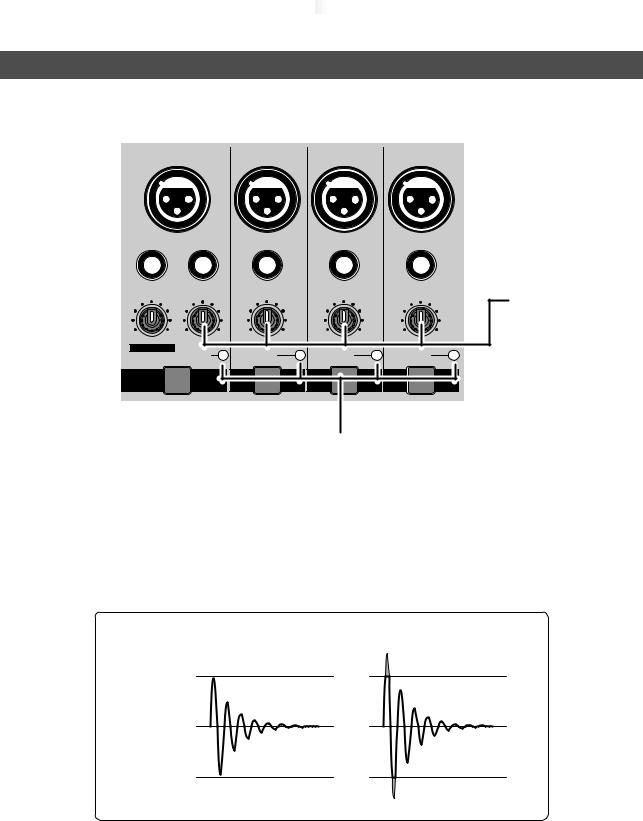
























































 MR-8HD Owner’s Manual (Read this chapter first!)
MR-8HD Owner’s Manual (Read this chapter first!)
[TRIM] control
You must pay great attention to the [TRIM] control adjustment when recording to the MR-8HD.
INPUT A |
|
INPUT B |
|
INPUT C |
|
INPUT D |
|
|
|
||||
BAL |
|
BAL |
|
BAL |
|
BAL |
UNBAL |
INSERT |
UNBAL |
UNBAL |
UNBAL |
/GUITAR |
||||
DISTORTION |
TRIM |
TRIM |
TRIM |
TRIM |
MIN |
MAX |
LINE |
MIC |
LINE |
MIC |
LINE |
MIC |
LINE |
MIC |
GUITAR |
|
|
|
|
|
|
|
|
|
PEAK |
PEAK |
|
PEAK |
PEAK |
ON |
|
ON |
ON |
ON |
OFF |
|
OFF |
OFF |
OFF |
[TRIM] control
PEAK LED
The analog signal received at each input ([INPUT A] through [INPUT D]) is sent to the TRIM control, by which the signal level fed to the A/D converter of the MR-8HD is controlled.
You can check this level by the PEAK indicator. If the level is too high, the PEAK indicator lights, while you may hear the sound distorted or noisy. This distortion (noise) generated at this stage cannot be eliminated, therefore, adjust the TRIM control properly so that the PEAK indicator does not light at the loudest part of the input signal.
Proper level |
The level is too high. |
Clipping level
Clipping level
15

MR-8HD Owner’s Manual (Read this chapter first!)




































































16


























































 MR-8HD Owner’s Manual (Names and functions)
MR-8HD Owner’s Manual (Names and functions)
Names and functions
This chapter describes the names and functions of the controls, keys, connectors, etc. on the MR-8HD top panel and rear panel, as well as details of the display. See this chapter whenever you want to know the function of a control, key, etc.
17
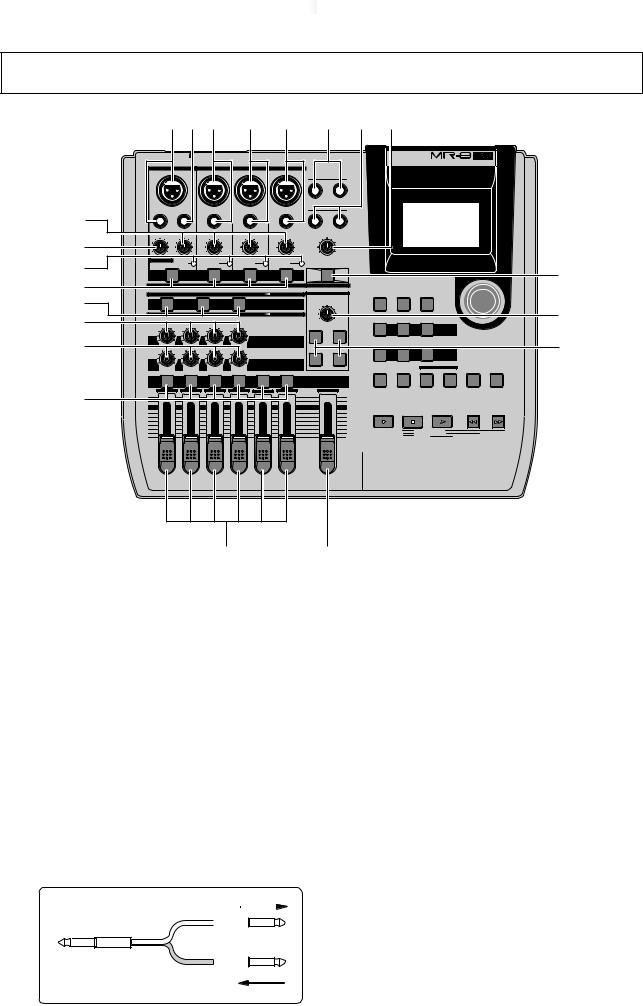
MR-8HD Owner’s Manual (Names and functions)

























































|
|
|
|
|
|
|
|
Top panel 1 |
|
|
|
|
||||||||
|
|
1 |
|
2 |
3 |
|
|
4 |
|
5 |
|
|
6 |
7 |
8 |
|
|
|
|
|
|
INPUT A SELECT |
|
|
|
|
|
|
|
|
|
|
|
|
|
|
|
|
|
||
|
|
|
|
|
|
|
|
|
|
|
|
|
|
|
|
|
DIGITAL MULTITRACKER |
|||
|
|
INPUT A |
|
INPUT B |
|
INPUT C |
INPUT D |
|
|
|
|
|
|
|
|
|
||||
|
|
BAL |
|
|
BAL |
|
|
BAL |
|
BAL |
|
STEREO OUT |
|
|
|
|
|
|
||
|
|
|
|
|
|
|
|
|
|
|
|
|
|
|
|
|
|
|||
|
|
|
|
|
|
|
|
|
|
|
|
L |
|
R |
|
|
|
|
|
|
|
UNBAL |
|
|
|
|
|
|
|
UNBAL |
PHONES |
|
|
|
|
|
|
||||
21 |
/GUITAR |
INSERT |
UNBAL |
|
UNBAL |
1 |
|
2 |
|
|
|
|
|
|
||||||
|
|
|
|
|
|
|
|
|
|
|
|
|
|
|
|
|
|
|
|
|
|
DISTORTION |
TRIM |
|
TRIM |
|
|
TRIM |
|
TRIM |
|
PHONES VOL |
|
|
|
|
|
|
|||
20 |
MIN |
MAX LINE |
MIC |
LINE |
MIC |
LINE |
MIC |
LINE |
MIC |
MIN |
MAX |
|
|
|
|
|
|
|||
|
|
|
|
|
|
|
||||||||||||||
19 |
GUITAR |
PEAK |
|
PEAK |
|
|
PEAK |
|
PEAK |
|
|
|
|
|
|
|
|
|
|
|
|
|
|
|
|
|
|
|
|
|
|
|
|
|
|
9 |
|||||
|
|
ON/ |
|
|
ON/ |
|
|
ON/ |
|
ON/ |
|
|
|
|
|
|
|
|
||
|
|
|
OFF |
|
|
OFF |
|
|
OFF |
|
OFF |
|
|
|
|
|
|
|
|
|
18 |
|
|
|
|
|
TO STEREO BUSS |
|
|
|
POWER |
|
|
|
|
|
|
|
|||
DYNAMIC |
|
CONDENSER |
|
TUBE |
|
MIC SIMULATION |
EFFECT |
|
RHYTHM |
TIME BASE |
CONTRAST |
|
|
|
||||||
17 |
|
|
|
|
|
|
GUIDE |
SELECT |
|
|
|
|||||||||
|
|
|
|
|
|
|
|
|
|
|
REVERB / DELAY TIME |
|
|
|
|
|
|
|||
|
|
|
|
|
|
|
|
|
INPUT A |
|
|
|
|
|
|
|
|
|
10 |
|
16 |
BRIT STACK |
|
US METAL |
|
60'S COMBO |
|
AMP SIMULATION |
|
|
|
1-6 > 7/8 |
1-8 >SONG |
7/8 >WAV FILE |
|
||||||
|
|
|
|
|
|
|
|
|
|
|
|
|
|
1-4 > 5/6 |
NEW |
STEREO |
|
|
||
|
|
|
|
|
|
|
|
|
|
|
MIN |
MAX |
|
|
|
|
|
|
||
|
|
|
|
|
|
|
|
|
|
|
ROOM |
|
HALL |
|
|
|
BOUNCE |
|
|
|
|
|
|
|
|
|
|
|
|
|
|
|
|
|
|
ABC1 |
DEF2 |
GHI3 |
|
MENU / ENTER |
|
15 |
|
|
|
|
|
|
|
|
EFFECT SEND |
|
|
|
|
|
11 |
|||||
|
|
|
|
|
|
|
|
|
|
|
POWERFUL |
NATURAL |
BRIGHT |
|
|
|||||
0 |
10 |
0 |
10 |
0 |
10 |
0 |
10 |
|
|
|
|
|
|
|
|
|||||
|
|
|
|
|
|
|
|
|
|
|
PLATE |
|
DELAY |
|
|
|
MASTERING |
|
||
|
|
|
|
|
L |
R |
L |
R |
|
PAN |
|
|
|
|
JKL4 |
MNO5 |
LOCATE |
|
|
|
|
L |
R |
L |
R |
|
|
|
|
|
|
|
|
|
|
||||||
|
|
|
|
|
|
|
AUTO PUNCH |
PLAY MODE |
A / IN |
B / OUT |
STORE |
UNDO/REDO |
||||||||
|
|
|
|
|
|
|
|
|
|
|
|
|
|
|
||||||
|
|
|
|
|
|
|
|
|
|
|
|
REC SELECT |
|
|
|
|
|
|
||
14 |
|
1 |
|
2 |
3 |
|
4 |
|
5/6 |
7/8 |
|
MASTER |
|
PQR6 |
STU7 |
VWX8 |
YZ9 |
+-_0 |
DELETE |
|
MAX |
|
|
|
|
|
|
|
|
|
|
|
|
MAX |
|
|
|
|
|
|
|
|
|
|
|
|
|
|
|
|
|
|
|
|
|
|
|
|
|
|
|
|
|
|
|
|
|
|
|
|
|
|
|
|
|
|
|
RECORD |
STOP |
PLAY |
REWIND |
F FWD |
|
|
|
|
|
|
|
|
|
|
|
|
|
|
|
|
|
LOCATE REC END |
|
|
||
|
MIN |
|
|
|
|
|
|
|
|
|
|
|
|
MIN |
|
LOCATE ABS ZERO |
|
|
||
|
|
|
|
|
|
|
|
|
|
|
|
|
|
|
A-B PLAY |
|
|
|
||
|
13 |
12 |
|
1. |
[INPUT A] input connectors (XLR |
3. |
[INPUT B] input connectors (XLR |
|
connector and phone jack) |
|
connector and phone jack) |
Both the [BAL] XLR connector and [UNBAL/ GUITAR] phone jack are provided. You can connect a guitar, microphone, keyboard, etc. If you connect sources to both the XLR connector and phone jack, the phone input takes priority. When using the [INPUT A] section, select the [INPUT A SEL] switch on the rear panel appropriately according to your usage (see page 33).
You can connect a guitar, microphone, keyboard, etc. to the [INPUT B] input.
Both the [BAL] XLR connector and [UNBAL] phone jack are provided so you can use the appropriate connector according to the sound source.
If you connect sources to both the XLR connector and phone jack, the phone input takes priority (see page 33).
2. |
[INSERT] connector (TRS phone jack) |
4. |
[INPUT C] input connectors (XLR |
|||||||||||
|
Connects an external effect processor (typi- |
|
connector and phone jack) |
|||||||||||
|
cally, a compressor/limiter, etc.). |
|
You can connect a guitar, microphone, key- |
|||||||||||
|
For connection between the MR-8HD and the |
|
||||||||||||
|
|
board, etc. to the [INPUT C] input. |
||||||||||||
|
effect processor, use a Y-cable as shown be- |
|
||||||||||||
|
|
Both the [BAL] XLR connector and [UNBAL] |
||||||||||||
|
low (see page 59). |
|
||||||||||||
|
|
phone jack are provided so you can use the |
||||||||||||
|
|
|
|
|
|
|
|
|
|
|
|
|
|
|
|
TIP: SEND |
To the effect input. |
|
|
|
|
|
appropriate connector according to the |
||||||
|
|
|
|
sound source. |
||||||||||
|
|
|
||||||||||||
|
|
|
|
|
|
|
|
|||||||
|
|
|
|
|
GND |
|
|
|
|
|
|
|
If you connect sources to both the XLR con- |
|
|
|
|
|
|
|
|
|
|
|
|
|
|||
|
|
|
|
|
|
|
|
|
|
|
|
|
|
|
|
|
|
|
|
|
|
|
|
|
|
|
|
|
nector and phone jack, the phone input takes |
|
|
|
|
|
|
|
|
|
|
|
|
|
|
|
|
|
|
|
|
|
|
|
|
|
|
|
|
|
priority (see page 33). |
|
|
|
|
|
|
|
|
|
|
|
|
|
|
|
|
RING: RETURN |
From the effect output. |
|
|
||||||||||
|
|
|
|
|
|
|
|
|
||||||
18


























































 MR-8HD Owner’s Manual (Names and functions)
MR-8HD Owner’s Manual (Names and functions)
5.[INPUT D] input connectors (XLR
connector and phone jack)
You can connect a guitar, microphone, keyboard, etc. to the [INPUT D] input.
Both the [BAL] XLR connector and [UNBAL] phone jack are provided so you can use the appropriate connector according to the sound source. If you connect sources to both the XLR connector and phone jack, the phone input takes priority (see page 33).
14.[REC SELECT] keys
Used to select the recording track(s). You can record onto up to four tracks simultaneously. Pressing a key arms or unarms the corresponding track(s).
Tracks 5/6 or 7/8 are armed or unarmed simultaneously (see pages 35 through 42).
15.[PAN] controls
Control panning for tracks 1 through 4.
6.[STEREO OUT] jacks (L, R)
These jacks output the stereo (L and R) buss signals. Connect these jacks to the monitoring equipment or master recorder (see pages 29 and 41).
7.[PHONES] jacks (1, 2)
Two jacks (1 and 2) are provided. You can use two pairs of stereo headphones with the MR-8HD (see page 29).
8.[PHONES VOL] control
Adjusts the headphone output level (see page 30).
9.[POWER] switch
Switches between standby mode and power on (see page 28). To turn off the power when the power is on, press and hold down the [POWER] switch for a few seconds.
<Note>: This switch cannot turn off the power completely. When this switch is "up", the MR-8HD enters standby mode (i.e. the power does not completely turned off). Therefore, if you do not use the MR-8HD for a long time, we recommend unplugging the power cord from the AC outlet.
10.[REVERB/DELAY TIME] control
This control adjusts the reverb time or delay time. When you select "ROOM", "HALL" or "PLATE" for the effect type, it adjusts the reverb time.When you select "DELAY", it adjusts the delay time. (See page 61.)
11.[EFFECT] keys
These keys are used to select the effect type. You can select from three reverb types (ROOM, HALL and PLATE) and a delay (DELAY). The selected key is lit (see page 60).
12.[MASTER] fader
Adjusts the stereo (L and R) buss output level (see pages 30 through 39).
13.Track faders
Each fader adjusts the track playback level. Each of track faders 5/6 and 7/8 controls the stereo signal (see pages 30 through 39).
16.[EFFECT SEND] controls
Control the amount of signals from tracks 1 through 4 sent to the internal effect (reverb or delay) (see page 61).
17.Insert effect selection keys
Used to select the insert effect (mic simulation or amp simulation) for the signal from the [INPUT A] jack.
When setting the [INPUT A SELECT] switch on the rear panel to "MIC/LINE", you can use the mic simulation effect. When setting the switch to "GTR/DIST", you can use the guitar amp simulation effect (see page 58).
18.[TO STEREO BUSS ON/OFF] keys
Each key selects whether or not sending the corresponding input signal to the stereo L/ R busses (see page 72). Each press of the key alternates ON and OFF. When ON, the key illuminates in green. When OFF, it is unlit. When the corresponding input is assigned to a recording track, the key flashes in green.
A long press of the key enters the input menu of the MENU mode, in which you can set phantom power on/off, panning, etc. (see page 128).
19.[PEAK] indicators
Each indicator lights when the input signal is overloaded (see page 15). You should adjust the input gain using the [TRIM] control so that the [PEAK] indicator does not light.
20.[DISTORTION] control
Controls the amount of the distortion effect for a guitar connected to the [XLR] connector or [UNBAL/GUITAR] jack (phone type) on the [INPUT A] channel.
This control is effective only when the [INPUT A SEL] switch is set to "GTR/DIST" (see pages 35 through 40).
21.[TRIM] controls
Each control adjusts the input gain of the corresponding input channel (see page 15, and 35 through 40).
19
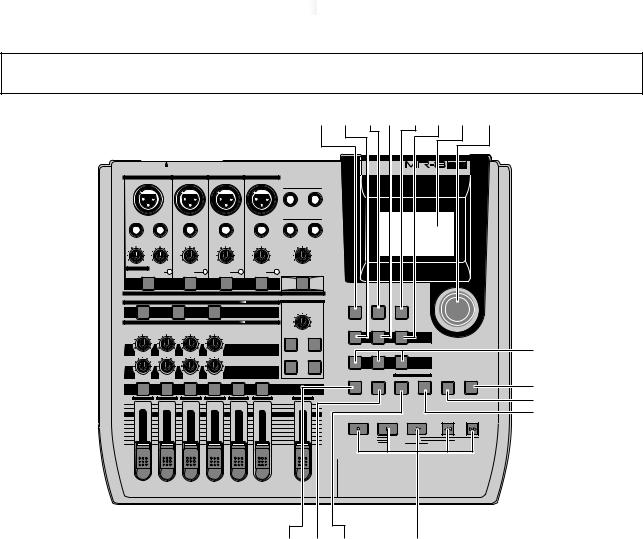
MR-8HD Owner’s Manual (Names and functions)

























































|
|
|
|
|
|
|
|
|
Top panel 2 |
|
|
|
|||||||
|
|
|
|
|
|
|
|
|
|
|
|
22 |
23 |
24 25 |
26 27 |
28 |
29 |
||
|
INPUT A SELECT |
|
|
|
|
|
|
|
|
|
|
|
|
|
|
|
|
|
|
|
|
|
|
|
|
|
|
|
|
|
|
|
|
|
|
|
DIGITAL MULTITRACKER |
|
|
|
INPUT A |
|
|
INPUT B |
INPUT C |
INPUT D |
|
|
|
|
|
|
|
|
|
||||
|
BAL |
|
|
|
BAL |
|
BAL |
|
BAL |
|
STEREO OUT |
|
|
|
|
|
|
|
|
|
|
|
|
|
|
|
|
|
|
|
|
|
|
|
|
|
|
||
|
|
|
|
|
|
|
|
|
|
|
L |
R |
|
|
|
|
|
|
|
UNBAL |
|
|
|
|
|
|
|
UNBAL |
PHONES |
|
|
|
|
|
|
|
|||
/GUITAR |
INSERT |
|
UNBAL |
UNBAL |
1 |
2 |
|
|
|
|
|
|
|
||||||
DISTORTION |
TRIM |
|
|
TRIM |
|
TRIM |
|
TRIM |
|
PHONES VOL |
|
|
|
|
|
|
|
||
MIN |
MAX LINE |
MIC |
LINE |
MIC |
LINE |
MIC |
LINE |
MIC |
MIN |
MAX |
|
|
|
|
|
|
|
||
GUITAR |
PEAK |
|
|
PEAK |
|
PEAK |
|
PEAK |
|
|
|
|
|
|
|
|
|
|
|
|
|
|
|
|
|
|
|
|
|
|
|
|
|
|
|
||||
|
|
ON/ |
|
|
|
ON/ |
|
ON/ |
|
ON/ |
|
|
|
|
|
|
|
|
|
|
|
OFF |
|
|
|
OFF |
|
OFF |
|
OFF |
|
|
|
|
|
|
|
|
|
|
|
|
|
|
|
TO STEREO BUSS |
|
|
|
POWER |
|
|
|
|
|
|
|
||
|
DYNAMIC |
|
|
CONDENSER |
|
TUBE |
|
MIC SIMULATION |
EFFECT |
RHYTHM |
TIME BASE |
CONTRAST |
|
|
|||||
|
|
|
|
|
REVERB / DELAY TIME |
GUIDE |
|
SELECT |
|
|
|||||||||
|
|
|
|
|
|
|
|
|
|
|
|
|
|
|
|
|
|
||
|
|
|
|
|
|
|
|
|
INPUT A |
|
|
|
|
|
|
|
|
|
|
|
BRIT STACK |
|
|
|
US METAL |
|
60'S COMBO |
|
AMP SIMULATION |
|
|
|
|
|
|
|
|
|
|
|
|
|
|
|
|
|
|
|
|
|
|
|
1-4 > 5/6 |
|
1-8 >NEW |
7/8 >STEREO |
|
|
|
|
|
|
|
|
|
|
|
|
|
|
MIN |
MAX |
1-6 > 7/8 |
|
SONG |
|
WAV FILE |
|
|
|
|
|
|
|
|
|
|
|
|
|
|
|
|
|
|
|
|
||
|
|
|
|
|
|
|
|
|
|
|
ROOM |
HALL |
|
|
|
|
BOUNCE |
|
|
|
|
|
|
|
|
|
|
|
|
|
|
|
|
|
|
|
|
|
|
|
|
|
|
|
|
|
|
|
|
ABC1 |
DEF2 |
GHI3 |
|
MENU / ENTER |
30 |
|
|
|
|
|
|
|
|
EFFECT SEND |
|
|
|
|
|||||
|
|
|
|
|
|
|
|
POWERFUL |
NATURAL |
BRIGHT |
|
|
|
|||
0 |
10 |
0 |
10 |
0 |
10 |
0 |
10 |
|
|
|
|
|
||||
|
|
|
|
|
|
|
|
|
PLATE |
DELAY |
|
|
|
|
|
|
|
|
|
|
|
|
|
|
|
|
|
|
|
MASTERING |
|
|
|
|
|
|
|
L |
R |
L |
R |
PAN |
|
JKL4 |
MNO5 |
LOCATE |
|
|
|
|
L |
R |
L |
R |
|
|
|
|
|
|
|
||||||
|
|
AUTO PUNCH |
PLAY MODE |
A / IN |
B / OUT |
STORE |
UNDO/REDO |
31 |
||||||||
|
|
|
|
|
|
|
|
|
|
|||||||
|
|
|
|
|
|
|
|
|
REC SELECT |
|
|
|
|
|
||
|
1 |
|
2 |
|
3 |
4 |
5/6 |
7/8 |
MASTER |
PQR6 |
STU7 |
VWX8 |
YZ9 |
+-_0 |
DELETE |
32 |
MAX |
|
|
|
|
|
|
|
|
|
MAX |
|
|
|
|
|
|
|
|
|
|
|
|
|
|
|
|
|
|
|
|
|
|
33 |
RECORD |
STOP |
PLAY |
REWIND |
F FWD |
|
|
LOCATE REC END |
MIN |
MIN |
LOCATE ABS ZERO |
A-B PLAY |
37 |
36 |
35 |
34 |
22.[RHYTHM GUIDE] key
Switches on/off of the rhythm guide function (see page 76). Each press of the switch alternates on and off. A long press of the key enters the rhythm guide menu, in which you can set the rhythm guide parameters (see page 76).
23.[BOUNCE 1-4 > 5/6, 1-6 > 7/8] / ABC1 key
Selects the bounce mode (see page 63).
In the menu mode, this key is used for character entry of A, B, C, a, b, c and 1 (see pages 32 and 99).
24.[TIME BASE SEL] key
Selects the time base shown on the display (see page 24). Each press of the key switch between "time" and "bar/beat".
25.[BOUNCE 1-8 > NEW SONG] / DEF2 key
Selects the bounce mode (see page 63).
In the menu mode, this key is used for character entry of D, E, F, d, e, f and 2 (see pages 32 and 99).
26.[CONTRAST] key
By rotating the [MENU/ENTER] knob while holding down this key, you can adjust the display contrast (see page 24).
27.[7/8 > STEREO WAV FILE] /GHI3 key
This key is used when converting a mono WAV file recorded on tracks 7/8 to a stereo WAV file (see page 90).
You can export the stereo WAV file to your personal computer over the USB connection (see page 92).
In the menu mode, this key is used for character entry of G, H, I, g, h, i and 3 (see pages 32 and 99).
28.LCD display
This 132 x 64 dot LCD display shows various information (see page 23).
29.[MENU/ENTER] rotary/push knob
Pressing this knob enters the menu mode. In the menu mode, rotating this knob selects the item or numeric value, while pressing this knob confirm the setting/selection.
20


























































 MR-8HD Owner’s Manual (Names and functions)
MR-8HD Owner’s Manual (Names and functions)
30.[MASTERING (POWERFUL/NATURAL/
BRIGHT] keys
Used to select the desired mastering effect during track bounce or mixdown. You can select from three effect types by pressing an appropriate key (see page 62).
In the menu mode, the [POWERFUL] key is used for character entry of J, K, L, j, k, l and 4, while the [NATURAL] key is used for character entry of M, N, O, m, n, o and 5(see pages 32 and 99).
31.[UNDO/REDO]/[DELETE] key
Used to undo or redo recording or editing (see pages 36, 38, 40).
Each press of the key alternates "undo" and "redo". In the menu mode, this key is used for deleting a character(see pages 32 and 99).
32.[STORE]/+-_0 key
Stores the current recorder position (time data) as the LOCATE A/IN or LOCATE B/OUT point (see pages 49 and 54).
In the menu mode, this key is used for character entry of +, -, _ and 0 (see pages 32 and 99).
33.[LOCATE B/OUT]/GHI3 key
Pressing this key while holding down the [STORE] key sets the LOCATE B point (or punch out point) (see page 49 and 54).
In the menu mode, this key is used for character entry of G, H, I and 3 (see pages 32 and 99).
34.Transport keys
[PLAY] key
Starts playback of the recorder.
Pressing this key while holding down the [RECORD] key starts recording of the armed (record-ready) track(s).
Pressing this key during recording exits recording.
[STOP] key
Stops the recorder.
By pressing the [PLAY], [REWIND] or [F FWD] key while holding down the [STOP] key, you can locate to a specific point or repeat playback as below.
• [STOP] + [PLAY] (A-B PLAY)
Repeats playback between the LOCATE A and LOCATE B points (see page 44).
• [STOP] + [REWIND] (LOCATE ABS ZERO)
Locates to the beginning (ABS ZERO) of the current song (see page 48).
• [STOP] + [F FWD] (LOCATE REC END)
Locates to the recording end of the current song (REC END) (see page 48).
[RECORD] key
Pressing the [PLAY] key while holding down the [RECORD] key starts recording of the armed (record-ready) track(s).
By pressing only the [RECORD] key when any track(s) is armed (in record-ready), the input signal(s) of the armed track(s) can be monitored (i.e. input monitor mode). (see pages 35 through 40).
[F FWD] key
Pressing this key fast forwards the recorder. During playback, pressing this key starts 3 x cueing (see page 44).
While holding down the [STOP] key, pressing this key locates to the recording end of the current song (REC END) (see page 48).
[REWIND] key
Pressing this key rewinds the recorder. During playback, pressing this key starts 3 x reverse cueing (see page 44).
While holding down the [STOP] key, pressing this key locates to the beginning (ABS ZERO) of the current song (see page 48).
This key is also used to go up the menu screen layer while a menu screen is displayed.
35.[LOCATE A/IN]/VWX8 key
Pressing this key while holding down the [STORE] key sets the LOCATE A point (or punch in point) (see page 49 and 54).
In the menu mode, this key is used for character entry of V, W, X, v, w, x and 8 (see pages 32 and 99).
36.[PLAY MODE]/STU7 key
Selects a play mode. You can select from among normal, auto play, auto return and loop (see page 45).
In the menu mode, this key is used for character entry of S, T, U, s, t, u and 7 (see pages 32 and 99).
37.[AUTO PUNCH]/PQR6 entry key
Turns on or off the auto punch mode (see page 55).
In the menu mode, this key is used for character entry of P, Q, R, p, q, r and 6 (see pages 32 and 99).
21
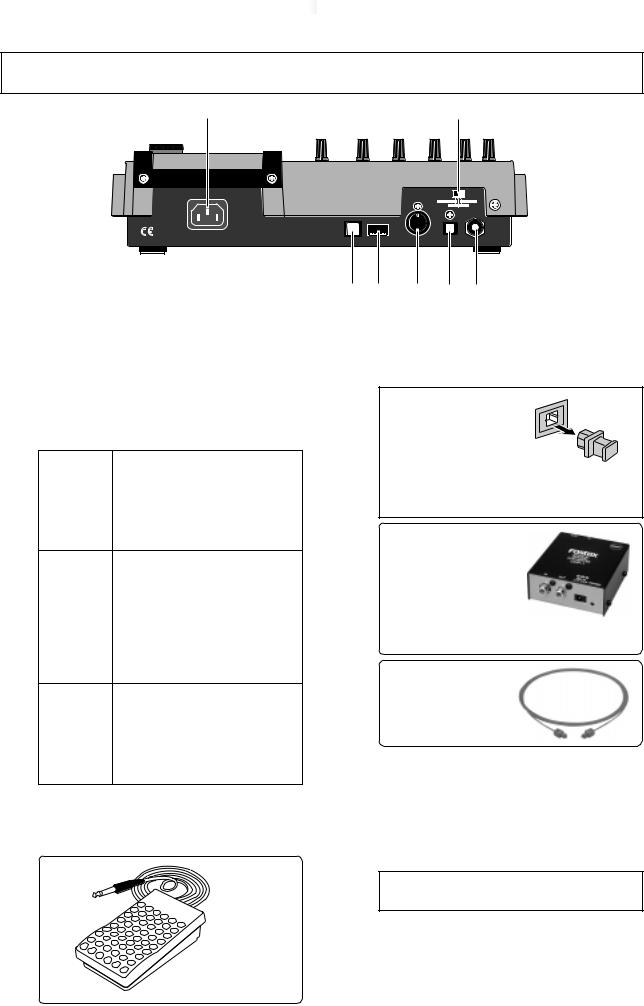
MR-8HD Owner’s Manual (Names and functions)

























































Rear panel
1 |
2 |
|
|
|
|
INPUT A SEL |
|
|
|
|
|
GTR CLEAN |
MIC/LINE |
|
|
|
|
GTR DIST |
|
AC-IN |
USB |
USB HOST |
MIDI OUT |
DIGITAL |
FOOT SW |
OUT |
|||||
1.[AC IN] connector
Connect the supplied power cord to this connector (see page 28).
2.[INPUT A SELECT] switch
This switch must be set appropriately according to the input source of the [INPUT A] channel (see page 33).
Either of the [BAL] XLR and [UNBAL/GUITAR] phone connectors can be used. Set the switch to
MIC/LINE
this position when the source is an external microphone or line level source.
Either of the [BAL] XLR and [UNBAL/GUITAR] phone connectors can be used. You can adjust
GTR DIST the input level and distortion using the [TRIM] and [DISTORTION] controls respectively. You can also use the amp simulation insert effect.
Either of the [BAL] XLR and [UNBAL/GUITAR] phone connec-
GTR CLEAN tors can be used. You can adjust the input level using the [TRIM]
control. You can also use the amp simulation insert effect.
3.[FOOT SW] jack (TRS phone jack)
Used to connect with an unlatched-type footswitch (see page 53).
unlatched-type footswitch
7 6 5 4 3
4.[DIGITAL OUT] connector
(Toslink optical connector)
Used to connect with an external digital device using an optical cable (see page 42).
<Note>: The dust protec-
tion cap is inserted to the [DIGITAL OUT] con-
nector when the unit is shipped.
Remove the cap when you use this connector. If you do not use this connector, attach the dust protection cap.
If you need to connect the unit to a digital device which only provides a coaxial type digital connector (typically, an RCA pin jack), use the Fostex COP-1/96k coaxial-
optical converter (shown
Model COP-1/96k
right).
Use an optical digital cable with Toslink plugs on both ends.
5.[MIDI OUT] jack (DIN 5-pin connector)
Used to connect to a MIDI IN jack of an external MIDI device (such as a MIDI sequencer) (see page 86).
6.[USB HOST] connector (USB A type)
Prepared for the future expansion.
<Caution>: Do not connect your personal computer to the [USB HOST] port.
7.[USB] port (USB B type)
Used to connect with a personal computer using a standard USB cable for song file data transfer between the MR-8HD and the personal computer (see page 92).
22
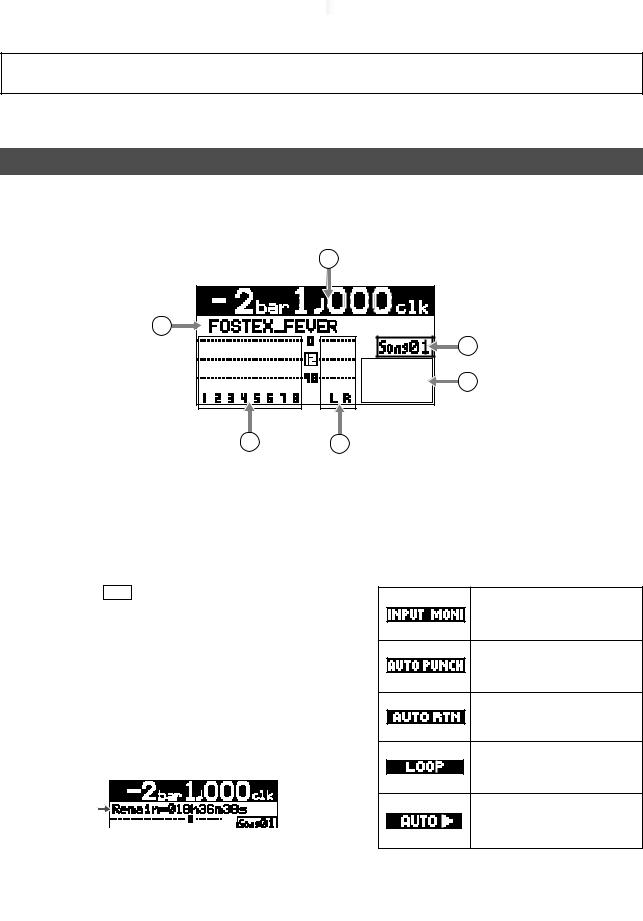

























































 MR-8HD Owner’s Manual (Names and functions)
MR-8HD Owner’s Manual (Names and functions)
LCD display
The following describes details about the LCD display, including screen contents and operation.
Home screen
When turning on the MR-8HD, the display shows the startup screen (showing the startup status of the MR8HD), followed by the "home" screen, which is similar to the one below. In this condition, the previously loaded song is loaded and the recorder is located at the beginning of the song.
The home screen provides the following information.
1
2 |
6 |
5 |
3
1.Time counter display
Time information of the current recorder position is shown in ABS or bar/beat mode (by default, bar/beat). Using the [TIME BASE SELECT] key, you can select a desired time base mode. When the recorder is moving (playing back, fast forwarding, etc.), the appropriate icon is also shown. While the hard disk drive is in access, " ACC " lights up.
2.Character display
Normally, the name of the song currently loaded is shown (up 16 characters can be shown at a time).
It also shows following information.
•A name of the operation mode currently being executed (such as "BOUNCE 1-6->7/8).
•A (not-so-serious) warning message
•The "Remain" time when at least one track is record-armed (i.e. At least one of the
[REC SELECT] keys is active).
The remain time shows how much time you can further record audio data onto a mono track using the available space left on the hard disk.
3.Track level display
The recording or playback levels of tracks 1 through 8 are shown. When a track is record armed, the track number indication changes to the source input channel (any of A, B, C and D).
4
4.Stereo buss (L and R) level display
During recording or playback, the output levels of the L/R stereo buss are shown.
5.Song status display
Lights up the following status icons when the appropriate modes (functions) are active.
At least one of the tracks is in the input monitor mode (see pages 36, 38 and 40).
The auto punch mode is active (see page 55).
The auto return mode is active (see page 45).
The loop mode is active (see page 45).
The auto play mode is active (see page 45).
6.Song number display
Shows the song number of the song currently
loaded. Also, " " is lit when the phantom power is on.
" is lit when the phantom power is on.
23
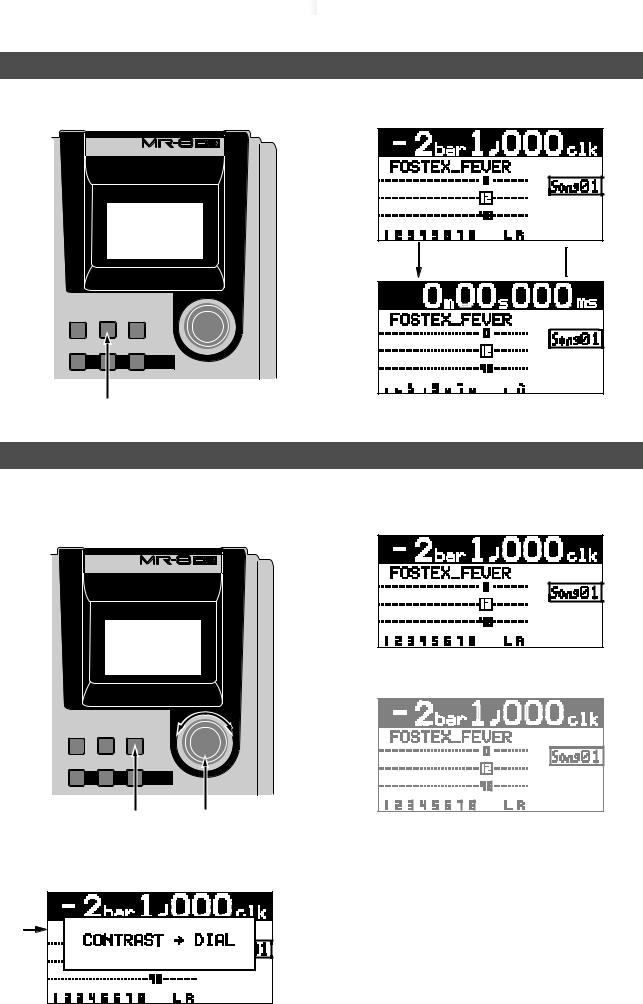
MR-8HD Owner’s Manual (Names and functions)

























































Selecting a time base mode
When the display shows the home screen, pressing the [TIME BASE SELECT] key switches the time base mode between ABS and bar/beat.
DIGITAL MULTITRACKER |
Example of bar/beat display 
RHYTHM |
TIME BASE |
|
|
GUIDE |
SELECT |
CONTRAST |
|
1-4 > 5/6 |
1-8 > NEW |
7/8 > |
STEREO |
1-6 > 7/8 |
SONG |
|
WAV FILE |
|
|
|
BOUNCE |
|
|
|
MENU/ENTER |
ABC1 |
DEF2 |
GHI3 |
|
|
|
|
|
|
|
|
|
|
|
|
|
|
|
|
|
|
|
|
|
|
|
|
|
|
|
|
|
|
|
|
|
|
|
[TIME BASE SELECT] key |
|
Example of ABS display |
||||||||||||||
|
|
|
|
|
|
|
|
|
|
|
|
|||||
Adjusting the display contrast
You can adjust the display contrast by rotating the [MENU/ENTER] knob while holding down the [CONTRAST] key. Rotating the dial clockwise heightens the contrast, while rotating it counterclockwise lowers the contrast.
DIGITAL MULTITRACKER
High contrast
RHYTHM |
TIME BASE |
|
|
GUIDE |
SELECT |
CONTRAST |
|
1-4 > 5/6 |
1-8 > NEW |
7/8 > STEREO |
|
1-6 > 7/8 |
SONG |
WAV FILE |
|
|
|
BOUNCE |
|
ABC1 |
DEF2 |
GHI3 |
MENU/ENTER |
|
|||
[CONTRAST] key |
[MENU/ENTER] knob |
||
|
|
|
Low contrast |
While pressing down the [CONTRAST] key, the display shows "CONTRAST -> DIAL".
24
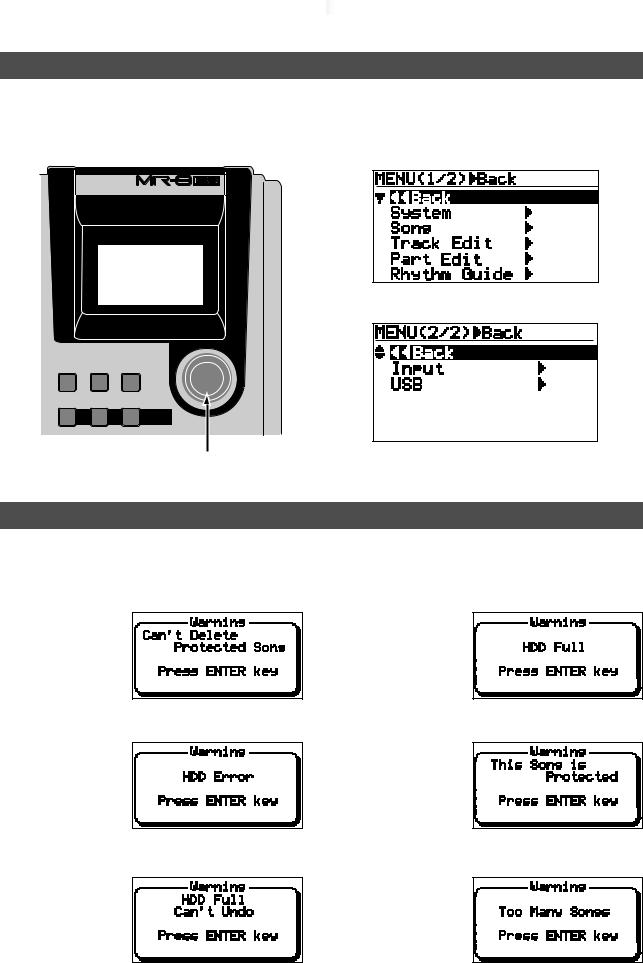

























































 MR-8HD Owner’s Manual (Names and functions)
MR-8HD Owner’s Manual (Names and functions)
MENU screen
Pressing the [MENU/ENTER] knob while the recorder is stopped enters the menu mode and brings up the menu screen.
In the menu mode, you can make setting or editing via the appropriate screen. The top menu screen has two pages, in which you can select the desired menu by rotating the [MENU/ENTER] knob.
DIGITAL MULTITRACKER
First page
RHYTHM |
TIME BASE |
|
|
GUIDE |
SELECT |
CONTRAST |
|
1-4 > 5/6 |
1-8 > NEW |
7/8 > |
STEREO |
1-6 > 7/8 |
SONG |
|
WAV FILE |
|
|
|
BOUNCE |
|
|
|
MENU/ENTER |
ABC1 |
DEF2 |
GHI3 |
|
[MENU/ENTER] knob |
Second page |
Warning message
If a serious problem happens to the MR-8HD during operation, an appropriate warning message is shown on the display. Most warning messages are being shown until the [MENU/ENTER] knob is pressed. Note that there are also not-so-serious warning messages besides the following.
This message is shown when you are going to delete a song which is protected.
This message is shown when the hard disk drive has a problem.
This message is shown when you are going to edit a track or part but there is not enough space on the hard disk for executing the undo function.
During recording, this message is shown if there is no more space left on the hard disk for recording.
This message is shown when you are going to make recording or editing to a song which is protected.
This message is shown when you are going to create a new song while 99 songs exist on the hard disk.
25

MR-8HD Owner’s Manual (Names and functions)

























































26



































































 MR-8HD Owner’s Manual (Basic operations)
MR-8HD Owner’s Manual (Basic operations)
Basic operations
This chapter describes power connection, power on/off, demo song playback, etc., as well as basic multitrack recording.
If it is the first time for you to use a Multitracker, read this chapter carefully first so that you are familiar with the MR-8HD basic operations, then read other sections which describe advanced operations.
27
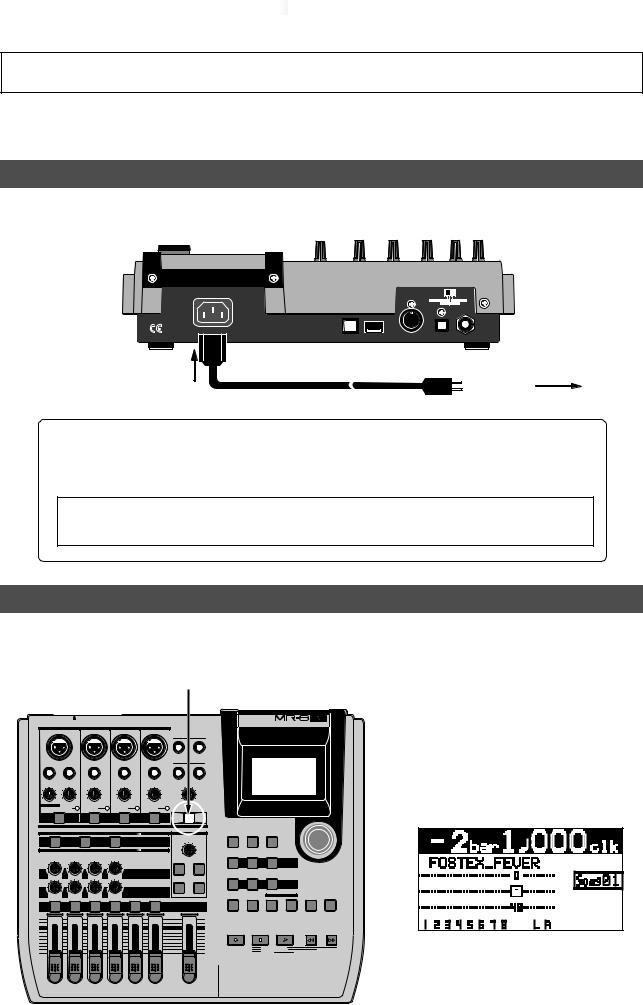
MR-8HD Owner’s Manual (Basic operations)

































































About power
The MR-8HD operates by AC power. Before you start using the MR-8HD, you must connect the supplied power cord.
Power connection
Connect between the [AC IN] connector on the MR-8HD rear panel and an AC outlet using the supplied power cord. The MR-8HD enters the standby mode when the power cord is connected.
|
|
|
|
INPUT A SEL |
|
|
|
|
|
GTR CLEAN |
MIC/LINE |
|
|
|
|
GTR DIST |
|
AC-IN |
USB |
USB HOST |
MIDI OUT |
DIGITAL |
FOOT SW |
OUT |
|||||
[AC IN] connector
AC outlet
Supplied power cord
About the standby mode
The standby mode is the condition when the power cord is connected and the [POWER] switch is set to OFF. In the standby mode, a small amount of power is consumed and the indicator of the [POWER] switch flashes slowly.
<Note>: When you do not operate the MR-8HD for a long period of time, we recommend disconnecting the power cord.
Turning on the unit
You can turn on or off the MR-8HD power using the [POWER] switch (pointed by an arrow below). To turn off the power, press and hold down the [POWER] switch for a few seconds.
|
|
|
|
[POWER] switch |
||
INPUT A SELECT |
|
|
|
|
|
|
|
|
|
|
|
|
DIGITAL MULTITRACKER |
INPUT A |
INPUT B |
INPUT C |
INPUT D |
|
|
|
BAL |
|
BAL |
BAL |
BAL |
STEREO OUT |
|
|
|
|
|
|
||
|
|
|
|
|
L |
R |
UNBAL |
|
|
|
UNBAL |
PHONES |
|
/GUITAR |
INSERT |
UNBAL |
UNBAL |
1 |
2 |
|
DISTORTION |
TRIM |
TRIM |
TRIM |
TRIM |
PHONES VOL |
|
MIN MAX LINE MIC |
LINE MIC |
LINE MIC |
LINE MIC |
MIN |
MAX |
|
GUITAR |
PEAK |
PEAK |
PEAK |
PEAK |
|
|
|
|
|
||||
|
ON/ |
ON/ |
ON/ |
ON/ |
|
|
|
OFF |
OFF |
OFF |
OFF |
|
|
|
|
TO STEREO BUSS |
|
POWER |
||
When you press the [POWER] switch to turn on the power for the first time, the MR-8HD starts up and the display shows the screen as below (note that it takes some time until the screen as below is shown).
This screen shows that the demo song is loaded and stopped at the beginning (ABS 0) of the song named "FOSTEX_FEVER".
DYNAMIC |
|
CONDENSER |
|
TUBE |
|
MIC SIMULATION |
||
|
|
|
|
|
|
|
|
INPUT A |
BRIT STACK |
|
US METAL |
|
60'S COMBO |
AMP SIMULATION |
|||
|
|
|
|
|
|
|
|
EFFECT SEND |
0 |
10 |
0 |
10 |
0 |
10 |
0 |
10 |
|
|
|
|
|
L |
R |
L |
R |
PAN |
L |
R |
L |
R |
|
||||
EFFECT |
RHYTHM |
TIME BASE |
CONTRAST |
|
GUIDE |
SELECT |
|
REVERB / DELAY TIME |
|
|
|
|
1-4 > 5/6 |
NEW |
STEREO |
MIN |
1-6 > 7/8 |
1-8 >SONG |
7/8 >WAV FILE |
MAX |
|
|
ROOM HALL
BOUNCE
MENU / ENTER
ABC1 |
DEF2 |
GHI3 |
|
POWERFUL |
NATURAL |
BRIGHT |
PLATE |
DELAY |
|
|
|
|
|
MASTERING |
|
JKL4 |
MNO5 |
|
|
|
|
LOCATE |
AUTO PUNCH PLAY MODE |
A / IN |
B / OUT |
STORE UNDO/REDO |
|
|
|
|
|
|
REC SELECT |
1 |
2 |
3 |
4 |
5/6 |
7/8 |
MASTER |
MAX |
|
|
|
|
|
MAX |
MIN |
|
|
|
|
|
MIN |
PQR6 |
STU7 |
VWX8 |
YZ9 |
+-_0 |
DELETE |
RECORD |
|
STOP |
PLAY |
REWIND |
F FWD |
LOCATE REC END
LOCATE ABS ZERO
A-B PLAY
Follow the procedure described on the next page to play back the demo song.
28
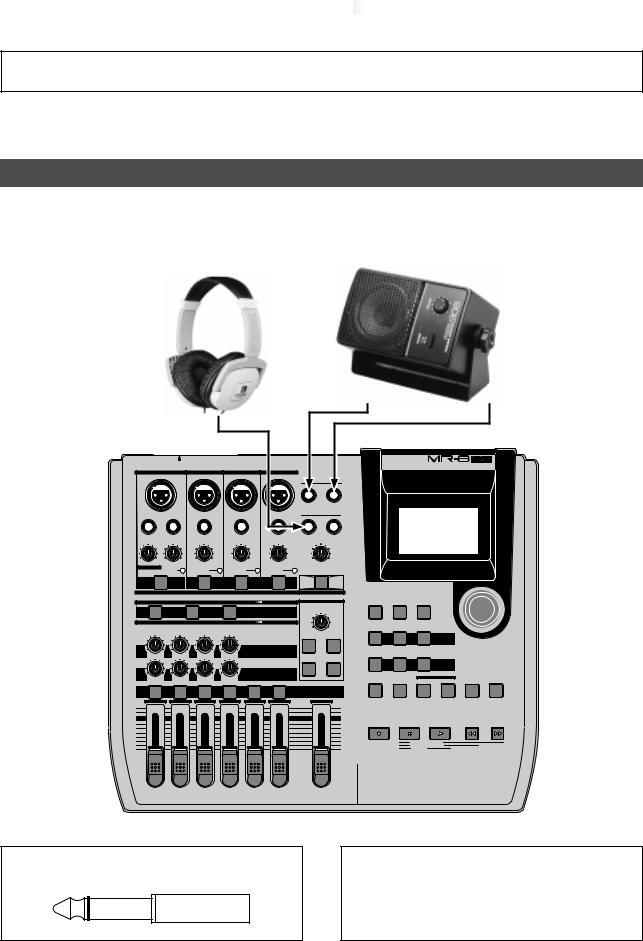


































































 MR-8HD Owner’s Manual (Basic operations)
MR-8HD Owner’s Manual (Basic operations)
Listening the demo song
A demo song is pre-recorded on the hard disk of the MR-8HD when shipped.
Before you make recording, let's listen to the demo song via headphones (or a monitor speaker).
Connecting headphones (or a monitor speaker system)
Connect headphones to either of the two [PHONES] jacks of the MR-8HD. Both jacks feed the same signal so you may connect headphones whichever you like.
If you have a powered monitor speaker, you may connect it to the [STEREO OUT] jacks of the MR-8HD.
Powered monitor speaker
Headphones |
|
|
||
INPUT A SELECT |
|
|
|
|
INPUT A |
INPUT B |
INPUT C |
INPUT D |
|
BAL |
|
BAL |
BAL |
BAL |
UNBAL |
INSERT |
UNBAL |
UNBAL |
UNBAL |
/GUITAR |
||||
DISTORTION |
TRIM |
TRIM |
TRIM |
TRIM |
MIN |
MAX LINE |
MIC |
LINE |
MIC |
|
LINE |
MIC |
LINE |
MIC |
|
GUITAR |
PEAK |
|
PEAK |
|
|
PEAK |
|
PEAK |
|
|
|
|
|
|
|
|
|
||||
|
|
ON/ |
|
|
ON/ |
|
|
ON/ |
|
ON/ |
|
|
OFF |
|
|
OFF |
|
|
OFF |
|
OFF |
|
|
|
|
|
TO STEREO BUSS |
|
|
|
||
DYNAMIC |
|
CONDENSER |
|
|
TUBE |
|
MIC SIMULATION |
|||
|
|
|
|
|
|
|
|
|
INPUT A |
|
BRIT STACK |
|
US METAL |
|
60'S COMBO |
|
AMP SIMULATION |
||||
|
|
|
|
|
|
|
|
EFFECT SEND |
||
0 |
10 |
0 |
10 |
0 |
10 |
0 |
10 |
|
|
|
|
|
|
|
L |
R |
L |
R |
|
PAN |
|
L |
R |
L |
R |
|
|
|
||||
|
DIGITAL MULTITRACKER |
|
STEREO OUT |
L |
R |
PHONES |
|
|
|
|
|
|
1 |
2 |
|
|
|
|
|
PHONES VOL |
|
|
|
|
|
|
MIN |
MAX |
|
|
|
|
|
POWER |
|
|
|
|
|
|
EFFECT |
RHYTHM |
TIME BASE |
CONTRAST |
|
|
|
|
|
GUIDE |
SELECT |
|
|
|
REVERB / DELAY TIME |
|
|
|
|
|
|
|
|
1-4 > 5/6 |
1-8 >NEW |
7/8 >STEREO |
|
|
MIN |
MAX |
1-6 > 7/8 |
SONG |
WAV FILE |
|
|
ROOM |
HALL |
|
|
BOUNCE |
|
|
|
|
|
|
|
||
|
|
ABC1 |
DEF2 |
GHI3 |
|
MENU / ENTER |
|
|
|
|
|||
|
|
POWERFUL |
NATURAL |
BRIGHT |
|
|
PLATE |
DELAY |
|
|
|
|
|
|
|
|
|
MASTERING |
|
|
|
|
JKL4 |
MNO5 |
|
|
|
|
|
|
|
LOCATE |
|
|
|
|
AUTO PUNCH |
PLAY MODE |
A / IN |
B / OUT |
STORE UNDO/REDO |
REC SELECT
1 |
2 |
3 |
4 |
5/6 |
7/8 |
MASTER |
PQR6 |
STU7 |
VWX8 |
YZ9 |
+-_0 |
DELETE |
MAX |
|
|
|
|
|
|
MAX |
|
|
|
|
|
|
|
|
|
|
|
|
RECORD |
|
STOP |
PLAY |
REWIND |
F FWD |
|
|
|
|
|
|
|
|
|
LOCATE REC END |
|
|
|
MIN |
|
|
|
|
|
|
MIN |
|
LOCATE ABS ZERO |
|
|
|
|
|
|
|
|
|
|
A-B PLAY |
|
|
|
||
<Note>: You can plug a 1/4" phone plug to the [STEREO OUT] L or R jack.
<Note>: When you connect a powered monitor speaker to the unit, turn down the volume of the powered monitor speaker to minimum before you turn on the MR-8HD and the powered monitor speaker.
29
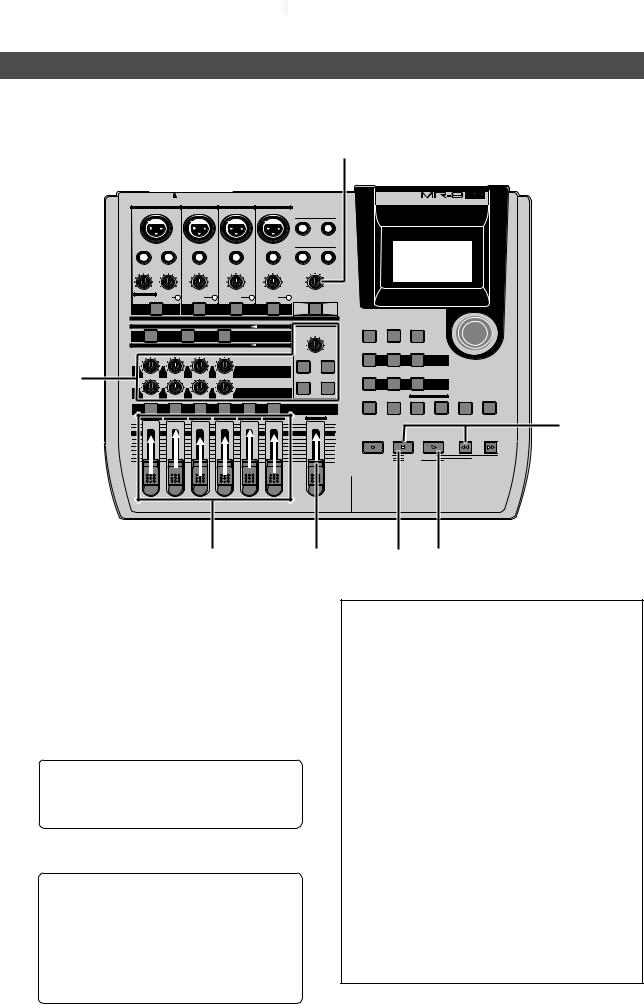
MR-8HD Owner’s Manual (Basic operations)

































































Playing back the demo song
In the demo song, approximately 1-minute audio is recorded on all eight tracks. Follow the procedure below for listening to the demo song. In the following procedure, it is assumed that the MR-8HD is turned on and a pair of headphones (or a monitor speaker system) is connected.
Hint-1
3
INPUT A SELECT |
|
|
|
|
|
|
|
|
|
||
|
INPUT A |
|
|
INPUT B |
|
INPUT C |
INPUT D |
||||
|
BAL |
|
|
|
BAL |
|
|
BAL |
|
BAL |
|
UNBAL |
INSERT |
|
UNBAL |
|
UNBAL |
UNBAL |
|||||
/GUITAR |
|
|
|||||||||
DISTORTION |
TRIM |
|
|
TRIM |
|
|
TRIM |
|
TRIM |
|
|
MIN |
MAX LINE |
MIC |
LINE |
MIC |
|
LINE |
MIC |
LINE |
MIC |
||
GUITAR |
PEAK |
|
|
PEAK |
|
|
PEAK |
|
PEAK |
|
|
|
|
|
|
|
|
|
|
||||
|
|
ON/ |
|
|
|
ON/ |
|
|
ON/ |
|
ON/ |
|
|
OFF |
|
|
|
OFF |
|
|
OFF |
|
OFF |
|
|
|
|
|
|
TO STEREO BUSS |
|
|
|
||
DYNAMIC |
|
|
CONDENSER |
|
|
TUBE |
|
MIC SIMULATION |
|||
|
|
|
|
|
|
|
|
|
|
INPUT A |
|
BRIT STACK |
|
|
US METAL |
|
60'S COMBO |
|
AMP SIMULATION |
||||
|
|
|
|
|
|
|
|
|
EFFECT SEND |
||
0 |
10 |
0 |
|
10 |
0 |
10 |
0 |
10 |
|
|
|
L |
R |
L |
|
R |
L |
R |
L |
R |
|
PAN |
|
|
|
|
|
||||||||
STEREO OUT
L |
R |
PHONES |
|
1 |
2 |
PHONES VOL |
|
MIN |
MAX |
POWER
EFFECT
REVERB / DELAY TIME
MIN MAX
ROOM HALL
PLATE DELAY
|
|
|
|
|
|
REC SELECT |
1 |
2 |
3 |
4 |
5/6 |
7/8 |
MASTER |
MAX |
|
|
|
|
|
MAX |
MIN |
|
|
|
|
|
MIN |
DIGITAL MULTITRACKER
RHYTHM |
TIME BASE |
CONTRAST |
|
|
|
GUIDE |
SELECT |
|
|
|
|
1-4 > 5/6 |
NEW |
STEREO |
|
|
|
1-6 > 7/8 |
1-8 >SONG |
7/8 >WAV FILE |
|
|
|
|
|
BOUNCE |
|
|
|
ABC1 |
DEF2 |
GHI3 |
|
MENU / ENTER |
|
|
|
|
|||
POWERFUL |
NATURAL |
BRIGHT |
|
|
|
|
|
MASTERING |
|
|
|
JKL4 |
MNO5 |
|
|
|
|
|
|
LOCATE |
|
|
|
AUTO PUNCH |
PLAY MODE |
A / IN |
B / OUT |
STORE |
UNDO/REDO |
PQR6 |
STU7 |
VWX8 |
YZ9 |
+-_0 |
DELETE |
Hint-2
RECORD STOP PLAY REWIND F FWD
LOCATE REC END
LOCATE ABS ZERO
A-B PLAY
1,3 |
1 |
4 |
2 |
1)Raise the [MASTER] fader to the " " position. Set the track faders at the lowest position.
" position. Set the track faders at the lowest position.
2)Press the [PLAY] key to start playback.
3)Raise the track faders (1 through 8) gradually to adjust the playback level and balance.
Also raise the [PHONES VOL] control gradually to adjust the headphones level. (If you are using a powered monitor speaker for monitoring, adjust the level control of the powered speaker.)
<Hint-1>: While listening to the playback sound, adjust panning setting of tracks 1 through 4, as well as try to adjust the internal effects (reverb/delay) (see page 60).
4)When the demo song ends, press the [STOP] key to stop the recorder.
<Hint-2>: To listen to the demo song again:
When the recorder is stopped after listening to the demo song, press the [REWIND] key while holding down the [STOP] key. The recorder instantly moves back to the beginning of the demo song (see page 48).
Then pressing the [PLAY] key starts playback from the beginning of the demo song.
<Note>: The demo song is protected and you cannot overwrite or erase it. Therefore, you cannot make recording in this condition.
If you want to make new recording while keeping the demo tape on the hard disk, see "Creating a song for recording" on the next page.
If you do not keep the demo song, carry out either of the following operations.
(1)Release the song protection (see page
101).
Then, start recording (overwrite recording) from the beginning of the demo song, or delete the demo song from the hard disk. If you delete the demo song, create a new song (see the next page) and make recording to the new song.
(2)Format the hard disk (see page 124) and
make recording.
Because a new song is automatically created after formatting the disk, you can start recording without the need of creating a new song manually.
30
